Animalpolis

How far do deer travel? (10 Facts You Should Know)
If you’re like most people, you may be wondering how far do deer travel, especially when in search of food or a bedding area.
A mature buck typically travels up to 2-3 miles or more per day. However, the highest recorded distance for an adult white-tailed deer was 200 miles which was over a period of 22 days, equivalent to 8.5 miles per day. In fact, some bucks can cover over 10 miles in a day if there’s enough good food source to draw it.
Deer typically travel in search of food and water and a better bedding area. Other factors that influence their travel distance and location are gender, maturity, nature of the terrain, rut, and availability of food. Ultimately, a deer will cover more distance in the dark and in areas with lots of forest cover.
Knowing how far deer travel is an important consideration, especially for hunters. In this article, we will look at how far deer travel and other interesting facts that relate to their movement and dispersion.

When Do Deer Travel?
Deer are usually found in areas with a lot of forest cover. They generally prefer moving at night or in low light conditions, including dawn or dusk. As early as 4 a.m, they commence their first trip to find food and water. And because of the way their retina is built, they can see very well in the dark, which is very important in keeping them safe from predators and hunters. On the other hand, during the day, deer are commonly found in their bedding area, relaxing, though this largely depends on how old the deer is.
Why do deer travel?
Deer travel is usually motivated by basic needs such as food, water and security until it’s time to breed. But for the better part of the year, deer bed where they are sure of security.
They are ruminant animals; hence bedding time is the time they use to fully digest their food. When hunger strikes again, they go back to feed. These movements are often done between sunrise and sunset. Although there are times when they move throughout the day, they sometimes bed during the day and night.
If hunting pressure increases, movement from deer will likely decrease. However, if they must move, they will move in places with more forest cover than out in the open to avoid being seen by hunters and other predators.
How far do deer travel?
Deer can cover an average distance of 1 to 200 miles, depending on the amount of forest cover in the area.
The average travel distance for young bucks is lesser and ranges from around 2 – 23 miles or more. This is also dependent on how well the area is covered. On the other hand, a mature buck can travel as long as 200 miles.
It is worth noting that deer are social animals, so they typically travel in groups, known as herds. In most cases, a herd is led by a strong male. But in some species, dominance can be segregated by gender. So, it is not uncommon to find a female deer leading a herd just as a male.
As earlier indicated, most deer trips occur between sunset and sunrise and in places with a lot of forest cover. During the daytime, you will normally find them in their bedding area.
How far do deer travel from their home?
According to research, a deer’s home range is usually within one square mile. This is where the animal spends most of its time throughout the year and can travel up to 100-150 yards in search of food and water.
Some deer can travel 10-20 miles from their home when exploring their surroundings. In total, a deer will only travel between 2 to 35 miles away from its home during its lifetime.
How far do deer travel during rut?
On average, a deer can travel as far as five miles or more from its home during rut.
Rut is usually that time of the year when bucks are on the chase for estrus does to mate with. It denotes the deer breeding season and all the activities and behaviors that come with it. During this time, most males usually move further from their home range in search of females that are ready to breed.
Usually, during rut, deer tend to become more active during the day as they search for females to mate with. They become more distracted and more vulnerable as prey for hunters. This is also the time when deer-vehicle accidents happen most.

Do deer travel the same path every day?
Deer often travel the same path every day, and this makes guessing their location very easy.
They are habitual animals; hence they repeat a particular sequence over and over. This is why most times, they could be found crossing signs in some places. Regardless of what might have happened to their friends, they continue to use the same route.
They leave their bedding area to look for food in a place that they are familiar with; then, they make the journey back home. As long as the feeding area continues to be a safe place for them, they will continue to ply the route every day.
However, depending on what the deer might be doing, this action may be more or less frequent. They may run along if it’s time for mating, or if they need to guide their young bucks, or just take a casual winter walk.
How do deer move?
Deer have different styles of movement – they can walk, gallop, trot, and even swim.
While galloping or running at full speed, a deer can jump up to 25 feet. Interestingly, the longest jump documented for a whitetail is slightly below 30-feet.
On the other hand, if a deer decides to sustain a walking pace, it can travel 3-4 miles in one hour. They tend to travel longer distances when trotting, often reaching 10-12 mph.
Swimming is the least way deer move as they are much more adept at using their legs on land. This doesn’t mean they are bad swimmers; however, they mostly swim short distances but may travel further if they need to. In other words, water doesn’t seem to prevent them from travelling.
When do deer move the most?
Deer typically move during sunrise and sunset. This is the time when they are less prone to attack by hunters and other predators. Most of their travels are usually to forage for food until breeding season. During the breeding season, deer tend to move more in the daytime in search of mates.
If hunting pressure increases, there will be a noticeable decrease in deer movement. However, if they are compelled to move during this time, they will move in the covered area of the forest and avoid open spaces where hunters and other predators can spot them.
When do deer change their pattern?
Deer movement pattern is mainly influenced by the location of food source until it’s time for them to breed. So, a deer typically changes its pattern when it can no longer find food in a certain area. But this is not the only time deer change their pattern.
A deer can also change its travel pattern if it feels threatened (afraid) by predators. So in a case where there’s no change in the location of food sources, a deer can still change its pattern if it doesn’t feel secure. Most times, this happens during early fall, which coincides with the archery (hunting) season in most regions. During this time, deer are compelled to change their travel pattern to avoid being hunted down.
Thus, security and food are the dominant factors that contribute to a change of travel pattern among deer. That is why a deer will bed where it feels most secure.
Which direction do deer travel?
A deer’s movement is not usually random but calculated and direct. In most cases, it is guided by its sense of smell. A deer could perceive corn miles away and will rely on its olfactory receptor to get there.
As a result, deer often rely on the wind to determine what direction to go. Thus, a buck will move upwind if he’s following his nose. This is commonly the case if it “smells any danger” ahead. That said, a deer can also decide to go downwind if there’s no sign of imminent threat.
In summary, deer use the wind to stay away from danger, find food and water, and even locate mating partners (does).
Frequently Asked Questions – FAQs
How far do deer travel in a day.
On average, a deer can cover up to 8 miles in a day if there’s enough forest cover available in the area. Sometimes, this can be up to 23 miles depending on the pressing need for food and water. In fact, during rut, a male can cover significantly more distance searching for an estrous doe to mate with.
How far do whitetail deer travel in a day?
A whitetail deer travel can travel up to 8.5 miles in a day, although this is largely dependent on the level of vegetative cover in the place as deer tend to move towards areas with considerable food and water supply. Thus, if there isn’t much vegetative cover in the area, the deer vegetative is likely to travel less for fear of getting caught in the open by hunters or other predators.
How far do female deer travel?
A doe can cover an average of 2- 3 miles daily. Here, they will normally take a routine walk close to their bedding area. They can also move in search of food and water or to take their young bucks for a light winter stroll.
Do deer stay in the same area?
Deer tend to stay in the same area as long as there is no drastic change in the amount of food and water available in the area. If there is a significant change in food and water availability, the deer will move to another area with better food supply and water. Also, if the security of their bedding area is threatened, or the forest cover becomes scanty, they will leave their bedding area to find a safer and more suitable place.
How far do deer travel from their bedding area?
A mature buck is usually within 100-150 yards from its bedding area. They cover that much distance mainly to look for food and water and typically move during the early hours of the day or at night. Besides the need to fill their bellies, they can also move to wash in nearby water sources.
Conclusion: how far do deer travel?
In summary, a deer travels an average of 1-200 miles, depending on the amount of forest cover in the place and age of the deer.
Forest cover is an essential component of good deer habitat, and it also determines other behavioral responses amongst deer. However, despite the importance of forest cover to deer, some young bucks raised in a forest with scanty covering may be able to travel up to 30 miles, sometimes even more.
If you have any more questions about how far do deer travel, let us know. Until then, happy exploring!
Other Interesting Topics:
Can Deer Smell Corn?
Do Deer Make Noise?
Similar Posts
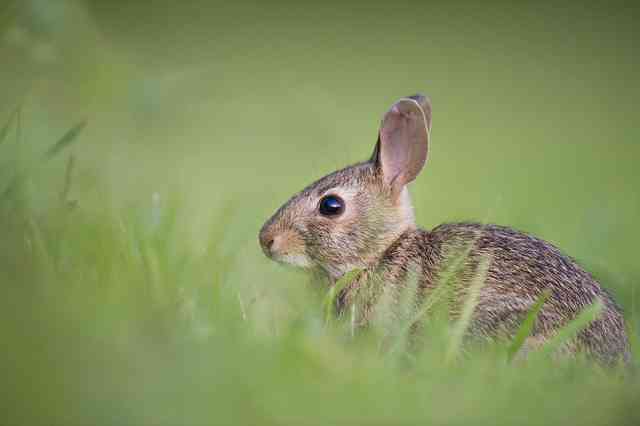
Do Rabbits Eat Geraniums? (Everything You Need To Know)

How Do Crickets Make Noise?
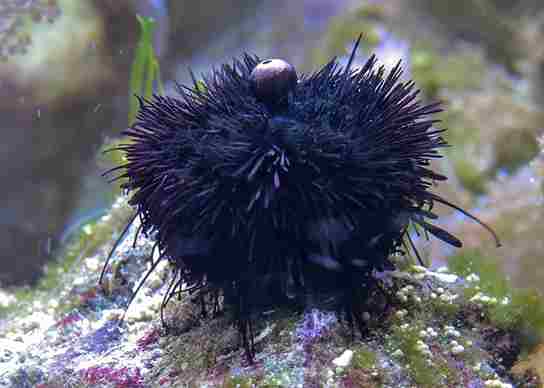
Do Sea Urchins Feel Pain? What Science Says!
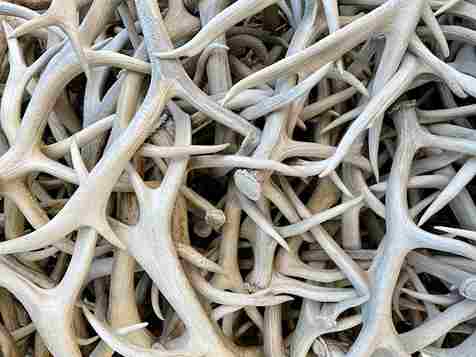
Deer vs. Elk Antlers for Dogs? How to Choose!
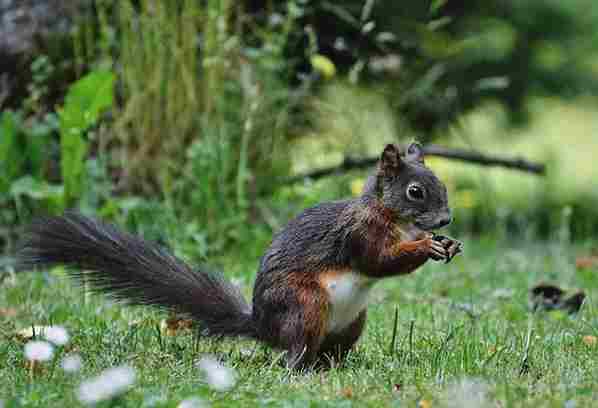
Do Squirrels Eat Dahlias? (Answered!!)

Do Spiders Eat Caterpillars? (8 Facts To Know)

- NEW - Mossy Oak Kids
- The Branch Newsletter
- NEW - Country Roots
- Country DNA
- Break-Up Country
- Elements Agua
- Elements Terra
- Shadow Grass Habitat
- Explore All Patterns
- GameKeeper Grants
- Conservation
- Wild Turkey Lab
- Write for Mossy Oak
- Meet Our Staff
- National Pro Staff
- Regional Pro Staff
- Marketing Services
- Licensees FAQs
- Free Fishing Knot Tying Guide
- Customer FAQs
- State Licensing
- Mossy Oak Kids
- Mossy Oak Fishing
- Gamekeepers
- Mossy Oak Properties
- Nativ Nurseries
- Gamekeeper Kennels
- MOOSE Media
- Gamekeeper Butchery
- Mossy Oak Golf
- Nativ Living
- Fishing Gear
- New Arrivals
- Turkey Hunting
- Turkey Vests
- Bottomland Book Club
- Wild Game Recipes
- Land Management
- Bucket List Trips
Home Range Movements: Understanding Seasonal Deer Movement
Bob Humphrey | Originally published in GameKeepers: Farming for Wildlife Magazine . To subscribe, click here .
The buck first showed up on October 3rd and provided a very pleasant and unexpected surprise considering we’d been running trail cameras since late August. My enthusiasm was tempered however by the time stamp on the image: 12:31 AM. The buck we named “Tall Boy” showed up again four days later and an hour earlier, and then vanished for a month…and the rest of bow season.
The next time he posed was an hour before daylight. That really got us going as the gun season was open and the rut kicking in. But we never laid eyes on him and despite running a half dozen cameras strategically over a square mile or so, we didn’t capture another image of him for three weeks. The next picture was taken ¾ of a mile away and again in the dark. Then Tall Boy went underground and didn’t surface again until after the December muzzleloader season. At least he’d made it through hunting season, but clearly more work needed to be done if we were going to sort out this buck’s home range and movement patterns before the next season.
We’d all like to know a lot more about where, when and how deer move about their regular haunts, but we can’t all go out and conduct a full-blown research project involving satellite telemetry and GPS collars. What we can do; however, is use general trends uncovered by that type of research, combined with what little we can glean from game cameras and personal observation and apply it to our own hunting grounds. Along the way, we might even learn a little bit about how to improve the odds of deer moving where we want them to by manipulating the habitat.
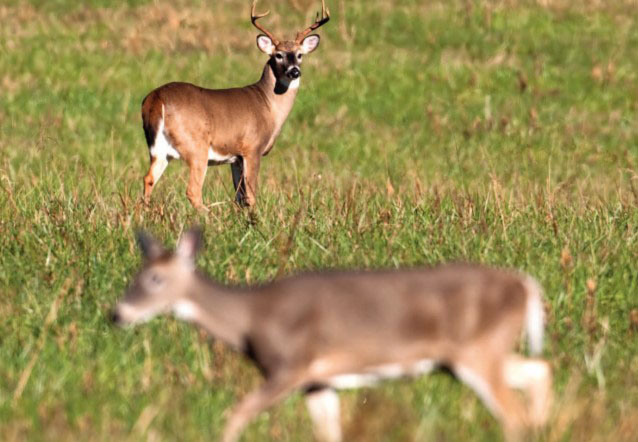
Definitions In order to better understand home range movements we must first better understand what is meant by “home range.” In layman’s terms it is the area occupied by an individual throughout the year. Biologists prefer more accurate descriptions. One widely accepted definition, by W.H. Burt is: ‘‘That area traversed by an individual in its normal activities of food gathering, mating and caring for young.” That seems clear enough but Burt also added: “Occasional incursions outside the area, perhaps exploratory in nature, should not be considered part of the home range.” That part is somewhat debatable, especially when it comes to whitetails, as we’ll see.
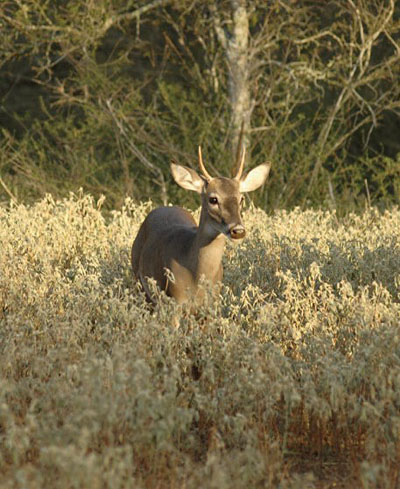
Since the advent of radio, and now GPS satellite collars, deer biologists can now define home range as where an individual spends 95 percent of its time over the course of an entire year. This definition also excludes those erratic forays or excursions. They then further refine this to include a Core Area, where a deer spends 50 percent of its time - places like bedding and preferred feeding areas.
Folks sometimes use the term territory to describe where a deer lives but there’s a distinct difference between “home range” and “territory.” A home range is the area merely occupied by an individual. A territory is something that is defended. Whitetails are, in general, not territorial. There are exceptions. In spring, at or around the time a doe is about to give birth she will drive off other deer from the birthing territory. This is a very temporary arrangement and will only last until the fawn can get up and walk on its own, perhaps a day or two. In the fall, a buck that is paired up with a hot doe will drive off any potential rivals so in essence, he is defending whatever patch of ground that doe happens to be standing on at that precise moment. But otherwise, deer are not territorial.
Clarification One of the most universally accepted tenets among deer hunters is that “a white-tailed deer has a home range of approximately one square mile.” That’s not necessarily true; and it’s easy to see why. The size of a whitetail’s home range is influenced by numerous factors that can vary considerably from one region or location to another to certain conditions or season to another, which we’ll address in a bit. However, if you were to compile all the data on whitetail home ranges throughout North America and calculate the average, it would probably come close to just over that one square mile. It’s important to remember that’s an average. The high end could be as much as ten to fifteen square miles where there is poorer quality habitat or low deer density, or in the “big woods” of some of the northern tier states or some states west of the Mississippi where they may have to travel long distances to meet their needs. Or it may be less than a square mile in rich agricultural land or densely developed areas.
Movement Variables The principal factor influencing how much, how far and where within its home range a deer moves is habitat, which consists of food, cover and water. The greater the quantity and quality of those habitat variables, the less a deer will have to move to find them. The lesson here for the land manager should be obvious. Increase the quality and lessen the variability of your habitat and you’ll attract and hold more deer. And for the hunter, those deer will move more within their and your home range.
Of course there is a law of diminishing returns, especially with bucks. As anyone who has ever seen a bachelor group can attest, bucks are quite social during late summer. That changes in the fall as hormones begin to flow and aggressive interactions increase. And while several studies suggest this may be a reason yearling bucks relocate their home range, one recent study found that not to be the case with older deer.
A South Carolina study found core areas of four adult bucks overlapped somewhat, three to a great degree. And this was during the hunting season when they should have been potential rivals. It’s likely that while they were in the same general locale they may not have been in the same immediate vicinity of each other, at least not at the same time. Like rival siblings, they didn’t move out of the house, they just moved to different rooms. Still, it shows that even intraspecific aggression will not prompt adult bucks to abandon their home range, or core areas.
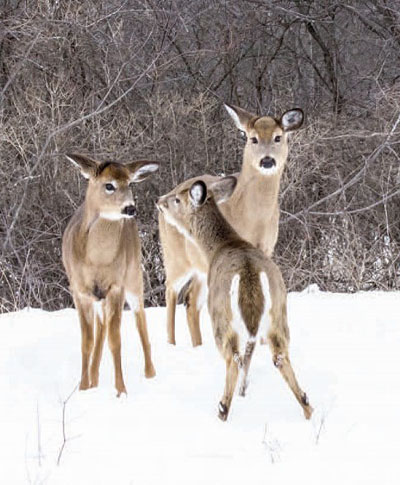
Much the same is true for hunting pressure. Several studies have found that rather than move out, mature bucks simply moved less during daylight, and more in thick cover in response to increased human (hunter) presence. That’s another important thing to know. You may not drive your hit list bucks off the property, but you will make them harder to kill if you pressure them too much.
The Dating Game Eventually bucks will have to move if they want to find a mate, and biologists have identified three different strategies they use to do so. When we think of buck movement during the rut, most hunters probably picture nomadic deer that travel far and wide, (perhaps as much as five miles or more from their core area) for an extended period of several days. This is not an uncommon scenario particularly, but not necessarily, when does are fewer and farther between. And both our definitions exclude these forays from the home range.
Some bucks make periodic excursions, traveling well outside their core areas and home ranges, but typically returning within 12-24 hours. Even more interesting, one study found that many of these bucks have two or more focal points - between 60 and 140 acres in size - within their home ranges that they re-visit every two days or so. Perhaps of greater interest to the hunter, researchers also found the focal points of several individual bucks overlapped during peak rut, and speculated bucks might be spacing their visits to assess female receptiveness. This suggests the traditionally accepted model of bucks visiting doe groups might actually have some basis in fact and offers some justification for including these excursion sites in a buck’s home range.
Finally, some bucks are “home bodies.” They remain largely within their home range, spending a considerable amount of that time in core areas, even during peak rut. It should be noted that one study found some of these sedentary bucks had one core area while others had multiple cores. Perhaps does were in good supply, or it could simply have been individual personalities, which actually influences movements more than most realize.
That last part is a very important thing to keep in mind when it comes to deer behavior but particularly with older deer - like humans, they all have distinct personalities. Some are homebodies while others have a wanderlust. However, like college kids, they always eventually return home.
Seasonal Shifts Another reason deer may shift home ranges and/or core areas is diet shifts. It’s been researched, discussed and written about ad nauseam so I won’t go into too much detail. Suffice to say, deer movements change when food availability or preference changes. Most gamekeeper-types already know that deer transition from predominantly proteins to increased carbohydrates and foods with higher fat content as summer changes to fall.
You need to understand what that means in the areas you hunt. Where I live, the deer are in the clover fields almost every night in August and early September but gradually shift away from the fields and into the woods where apples and acorns begin to drop as the days grow cooler and shorter.
Different foods ripen or become more available at different times. I witnessed this on a Kansas hunt where the deer had been regularly seen in the soybean fields until we arrived to hunt. Initially we thought it was our appearance and the associated disturbance. Then we realized ripe persimmons were dropping and deer were literally walking non-stop across bean fields to get them.
In the northeast, white oak acorns fall first, and often over a fairly short duration. The deer gobble the sweeter nuts up while they can in deference to the bitterer, but larger red oak acorns that will continue to drop over a more prolonged period and get more attention later. Midwestern and western hunters know how dramatically deer movement can change when the corn or alfalfa is cut. Every area is different and you need to figure out yours.
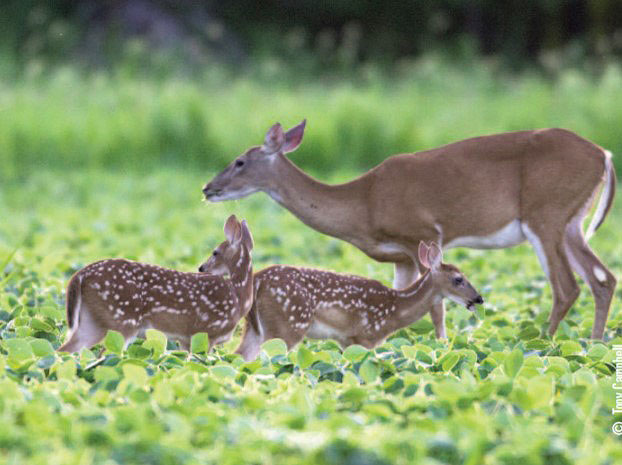
Shifting Seasons Another thing that can influence home range movement is climate. Deer hunters living east of the Mississippi and south of the Mason-Dixon Line may not fully appreciate just how dramatic the changes can be. Those of us in the North Country or western mountains know the difference.
I occasionally hunt an area of northern Maine that lies along the Canadian border. While local folks hunt whenever the season is open, older hunters have learned to save their energy until the mercury drops and the snow accumulates. Just over the border lies a large traditional wintering area (see sidebar) and deer will migrate to it from as far as ten to twenty miles away once winter conditions set in. Much the same occurs in mountainous areas of western states where deer and elk move down into the valleys. In slightly milder climates it’s common to see deer move to and congregate in areas of dense bottomland softwood cover and/or south facing slopes. And it’s also important to manage for these important winter habitats if you’re in these areas.
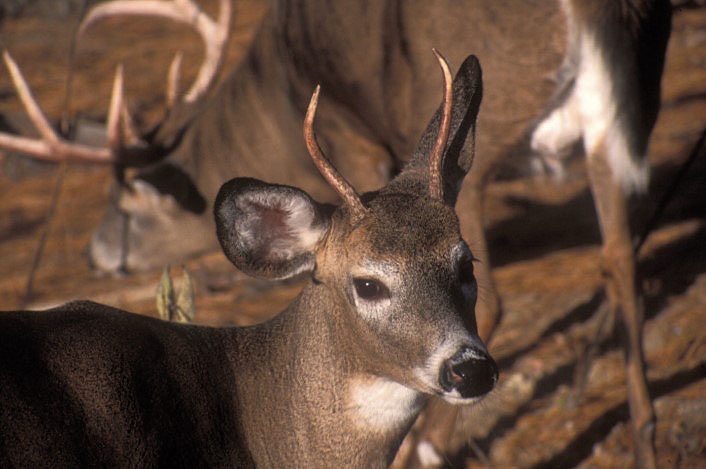
Conclusion To recap, after about the age of two, a deer will spend most or all of the remainder of its life within a defined area called a home range. Most of that time will be spent within a smaller portion of that is called a core area. The most notable exception is when bucks leave core areas and sometimes home ranges in search of a mate — sometimes.
Otherwise, core areas may shift seasonally with changes in food availability or preference, but deer will still remain within their home range. And that home range can range from very small to very large depending on habitat quality, deer densities and other variables. In good habitat and a moderate climate it may be a relatively small area. In more severe climates a deer’s home range may consist of summer and winter core areas that could be as much as ten to twenty miles apart. All that information is helpful but deer are individuals. If you want to figure out the one at the top of your hit list, you’ve got to put in your time in the field.

- Share This Story
Trending Gear

Latest Content

- Skip to primary navigation
- Skip to main content
- Skip to footer

Tree Stand Ranger
Hunting Guides, Updates, Tips & Gear Reviews
How Far Do Deer Travel? Deer Herd Day & Night Movement (2024)
May 8, 2024 by Alex David
Determining how far do deer travel is one of the major things for every hunter. Tracking their pattern is essential to make the most of your hunting. It helps you to figure out where you can find deer in great numbers.
On a broader range, the average distance that deer can travel in a day is 1.9 to 23.6 miles. However, a deer is likely to travel 2 to 3 miles per day. Some might cover even more distances. Forests that have scant covers have a higher dispersal rate.
Deer travel in search of feeding or bedding areas in heavy vegetation and covers, respectively. They also change their location during harsh weather conditions to find safer spots. Sometimes these animals move to find their mating partner.
Do you wonder when, where, and how far do deer move? If so, check out the detailed guide based on our personal experience.
Deer Travel Patterns – How Far Do Deer Travel?
Deer are one of the most difficult animals to chase but, if you crack the secret code of their travel, things come in your hand. So, do they move more in the morning or evening?
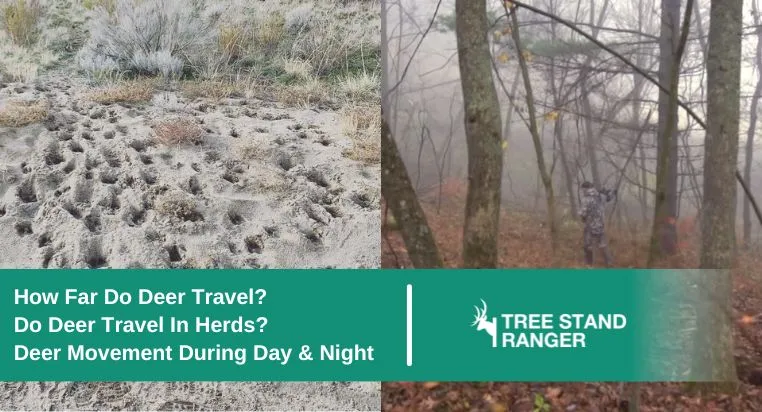
Since they are nocturnal creatures, their activity is increased as the evening hours start and reduced in the daylight. Though they do travel when the sun is up, you have to determine where and how far do deer travel in a day.
A study on a whitetail buck revealed that it traveled around 300 kilometers (186.4 miles) within a passage of 22 days. The average migration rate, also known as, how far do deer travel daily then becomes 13.6 km (8.54 miles).
In simpler words, this distance equates to covering an interstate highway or crossing a large river nearly seven times back and forth.
This study was further verified by a couple of scientists who conducted a survey male whitetail deer densities. According to the study, the animal’s walkabout was recorded over 174 km (108.1 miles) longer than any other buck ever recorded.
Do Deer Travel Alone?
When it comes to locomotion, hunters wonder do deer travel in packs or all alone. You might rarely notice an adult or mature buck traveling alone from one place to another. Because these animals are always looking around for potential danger, they prefer moving with a group of deer including fawns and doe for safety.
However, as the rut season begins, doe moves separately for the season. That said, whenever hunters spot a small group of deer, they instantly know these are button bucks (slightly larger antlerless deer having a flat head from the top between ears).
Speaking of the whitetails, they also like to move with other deer around. Generally, a buck travels with three or more bucks. However, the possibility of this animal seldomly moving alone cannot be ruled out.
The simple answer to the common question i.e., do deer travel in herds is yes. But, is it the case throughout the year? No. Deer daily routine of moving is impacted by different seasons, for example:
- Summer: Some does give birth to young ones during summer. All deer including bucks, does, and baby deer stay and move together in large herds.
- Autumn: Does in estrus might stay close in groups. Some bucks travel together to pursue the does in heat.
- Winter: All deer will come together once again and migrate from one place to another in search of food.
- Spring: This is the time when does begin giving birth and the process continues till summer. The females at this time of the year are separated from bucks temporarily and stay close to their younglings. Bucks however continue traveling in bachelor herds.
How Many Deer Usually Travel In A Group?
The number of deer in a herd keeps varying from season to season. When the buck and does travel in separate packs, there are generally 3 to 5 of them. One dominant male or female that is stronger than all the others in the group is the leader.
When does travel with their fawns, the number of animals in the herd can range between 40 to 70. However, when the entire deer community locomotes in social groups, there could be as many as 200 to 400 or even more. In this case, a large group of does and younglings is followed by another large herd of bucks that look after them and provide safety.
How Do Whitetail Deer Travel?
Whitetails also have an average migration rate of 2 to 5 miles daily. Hunters notice a slight increase in the travel patterns of bucks when they are searching for their female partners during the rut season. Therefore, pre rut and rut hunting is pretty common in Northern States of USA. Rattling antlers are used as bait to attract bucks and does towards ground blind or best hunting stand .
Do Deer Travel The Same Path Every Day?
A lot of hunters question how do deer travel once they find a route to their feeding and bedding areas. In simple words, the game animals stick to a particular path for days or even years if it leads them to their needs.
That is why tracking deer travel corridors using their trails helps hunters to determine their patterns. For that purpose, trail cameras are used. You can mount the cameras in a safe place such as a tree trunk and monitor the deer activity from your home, vehicle, or camp on your smartphone.
The best setup would be keeping the trail camera at a height of 3 ft. (deer’s average height) from the ground. To make these out of the line of sight from deer, mount them at 6 to 7 ft. above the ground.

Make sure that it faces the North or else bright sunlight can cause unclear images. Leave the camera for at least a week to determine the regular deer travel patterns in that particular area.
Once you have understood the path, stay low in the area between deer travel corridors i.e., two places where these animals move to and from. This brings loads of possibilities of seeing deer every day since they won’t alter the route.
The factors impacting daily deer travel routes include extreme weather conditions such as thunderstorms, heavy snow, or high winds (check deer movement in wind ).
Sometimes, when their feeding site falls short of vegetation, deer are likely to change their everyday route. They will search for another site to feed themselves and stick to it as long as it provides them with food.
Do Deer Move During The Day?
While deer are most active through the night hours, they sometimes move during the day as well. There could be some serious reasons that force deer to move in daylight such as, extreme cold, wind or rain, hunters around, or low availability of food. Understand habits of deer while travelling in rain
How Far Do Deer Travel During Rut?
During the rut, deer movement radius increases and they move slightly more than the regular days. If a buck covers a distance of 6 miles on a regular day, it would roughly travel 12 to 15 miles daily, during rut season.
How Deer Move With The Moon?
While moon phases are irrelevant to deer’s biology but do affect their movement. Bucks move more during a full moon night since it shines brighter. This is because they get better visibility even during full moon nights. In full moon, I have noticed an increased activity from male deer on trail cameras as compared to regular dark hours.
How Do Deer Move?
There are many interesting ways such as walking, trotting, running, and swimming.
They walk freely at a pace of 3 to 4 miles per hour if there is no danger detected around. A slight increase in the speed i.e., up to 10 to 12 miles per hour results in trotting.
Deer would trot if they need to cross an area with potential predators. When moving at the same pace non-stop for an hour, these animals are likely to travel nearly 40 miles.
They mainly trot when sense hunting pressure in the area i.e., too many hunters looking to take down game animals.
It is just an estimation and deer won’t travel this much since their home is within a maximum range of one square mile.
- Running/Galloping
Speed a little high and the deer will start running, commonly known as galloping. They run as fast as 35 to 40 miles per hour. The jumps can sometimes be as high as 25 feet.
Not many hunters know but yes, deer do swim and are pretty good at it. They usually cross ponds or rivers either to find food or escape danger. Deer have extremely powerful hind legs which help them swim with great power and stamina. That said, these animals can cover nearly 10 miles in one go.
Why Do Deer Gallop?
Galloping allows deer to move the fastest and they do it when they sense a solid danger around. This is usually when they see, hear, or smell humans, bears, cougars, or other predators.
Mule Deer Travel Patterns – How Far Do Mule Deer Travel?
Similar to the whitetails, mule deers are the most active right before dusk and after dawn. The regular travel distance covered by these animals is between 4 to 6 miles in one day. However, under high hunting pressure, mule deer would accelerate their travel distance and can cover about 10 miles in a day.
How Do Deer Travel Ridges?
You will never find whitetails or mule deer wandering on top of the ridges. They take the benefits of uneven terrains and would move about three-quarters (3/4) toward the downside of the ridge.
Hunting is an activity loaded with adventures that need an expert skill set and adequate knowledge. One of the most important things to understand before officially beginning hunting is how far do deer travel.
In simple words, deer will cover 1.9 to 23.6 miles per day based on stamina, age, and hunting pressure. Deer are likely to stay within their home range i.e., 650 yds. and travel inside this radius.
If you are learning how to hunt deer , make sure to understand the trail signs that deer leave and follow these appropriately to chase the game animal successfully.
Frequently Asked Questions (FAQ’s)
There is no specific distance that deer travel from where they are born. Some would travel a few miles whereas, others would like to cover many miles from their birthplace. Female fawns usually stay with their mothers whereas, male fawns are taken away to join bucks.
Chronic Wasting Disease, short for CWD infects animals like deer, moose, elk, sika deer, and reindeer. It happens when the animal has a prion (a single abnormal protein), causing holes in the brain. These holes or lesions make the cortex and cerebellum look like a sponge. As a result, deer experience drastic weight loss, tremors, and confusing behaviors, making them move abnormally in circles for a prolonged time.
Deer usually bed down during the daytime and travel at night. However, some do move during the day as well in search of food. That said, you can find them near food plots, and heavy vegetation including shrubs, grasses, leaves, etc.

About Alex David
I am an avid bow hunter and author of Tree Stand Ranger. Hunting from tree stands has been a passion of mine for many years. I’ve had the privilege of owning several tree stands and hunting properties throughout my life, and I take great pride in having the opportunity to do so. Read more about me .
Related Hunting Guides
- Best Tree Stand For Bow Hunting Deer 2024
- Best Ladder Tree Stand For Bow Hunting 2024
- Best 2 Man Ladder Stand 2024
- Best Climber Tree Stand 2024
- Best Hang On Tree Stand 2024
- Best Quadpod Deer Stand 2024
- Best Tripod Hunting Stand 2024
- Best Saddle Platform 2024
- Best Run and Gun Tree Stand 2024
- Best Budget Tree Stands 2024
Hunting Trip Essentials
- Best Tree Stand Blinds 2024
- Best Tree Stand Umbrella 2024
- Best Tree Stand Seat Cushion 2024
- Best Heater For Deer Blind and Tree Stand 2024
- Best Screw In Tree Steps 2024
- Best Climbing Sticks For Saddle Hunting 2024
- Best Tree Stand Harness 2024
- Best Tree Stand Accessories 2024
Leave a Reply Cancel reply
Your email address will not be published. Required fields are marked *
Save my name, email, and website in this browser for the next time I comment.
FIELD TEST RESULTS
- Best tree stands
- Best ladder stands
- Best hang on stands
- Best climbing stands
ABOUT TREE STAND RANGER
Treestandranger.com is a participant in Amazon Associate Program. As an associate, treestandranger.com earn affiliate commissions from qualifying purchases.

Recognizing Deer Movement Patterns
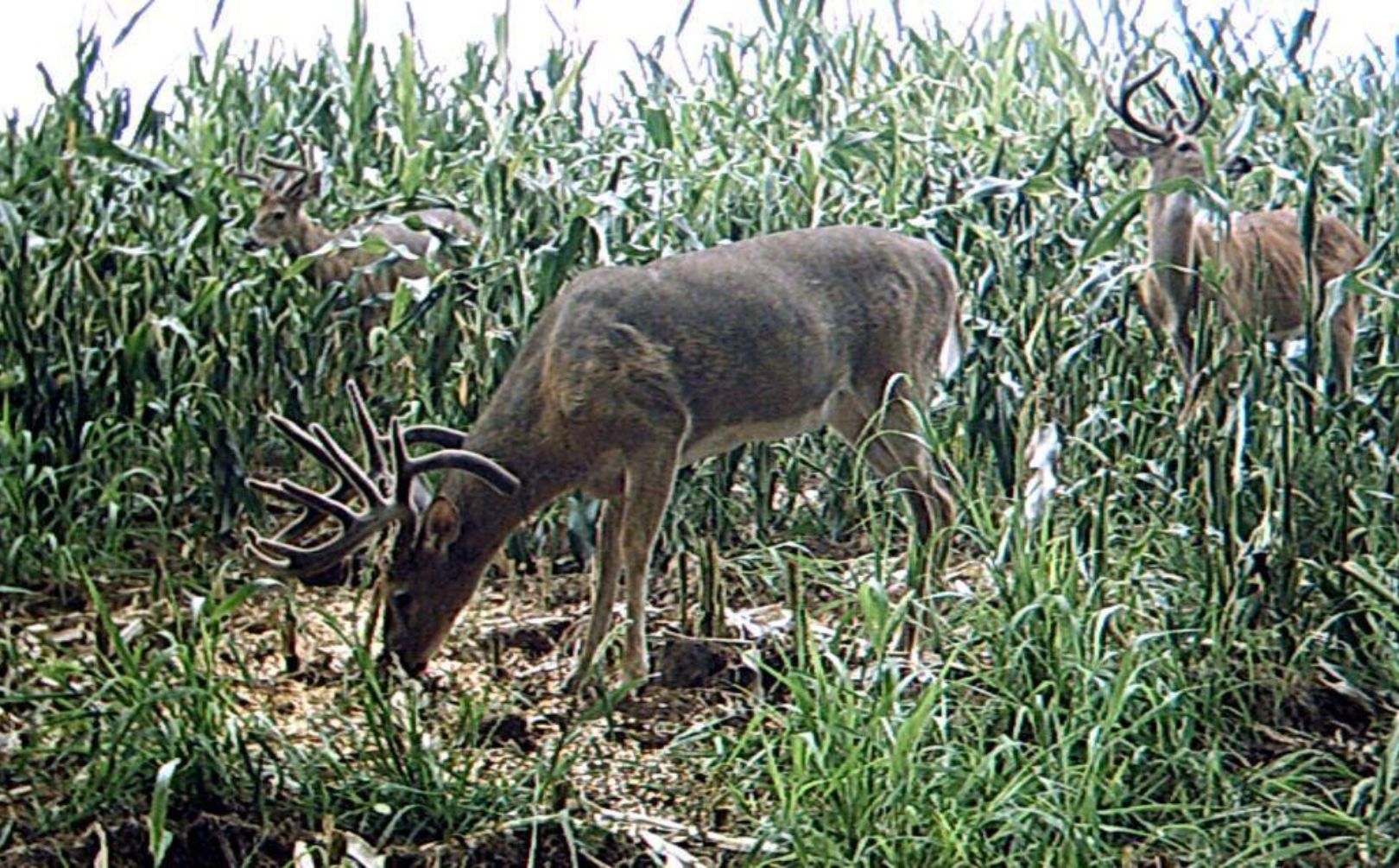
I would like you to take the time to reflect on the established deer movement patterns that are found on your favorite hunting grounds. Are they consistent? Do the patterns continue from year to year? And more importantly, where does the herd feed, where do doe family groups bed, where do bucks bed, and is there any room left over for mature bucks?
*The typical daily deer movement pattern includes these key components: Food to Doe Bedding to Doe/Buck Bedding Mix to Mature Buck Bedding...and then back again.

If you enjoy advanced whitetail strategies, you'll love my Whitetails By Design Book Series!
There is a huge opportunity awaiting the savvy hunter or land manager when it comes to recognizing established deer movement patterns. Now, this may seem like an pretty basic concept, but it isn't! Many times the opportunity for finding or creating deer movement patterns that establish an orderly sequence of preferred daily bedding patterns is missed. However, the opportunity for you is this: If you can recognize the naturally preferred deer movement patterns on the lands that you hunt, there may be no better deer hunting and deer habitat related effort that you can practice. If you follow along I am going to discuss the 3 conditions that you need to have, in order to take advantage of preferred deer movement patterns. Also, stay tuned until the end because after precision deer movements have been recognized, it is time for the hunting strategies that follow!
1. Food Defines The Base of All Deer Movement Patterns
The most predictable and easily recognizable movements in the deer woods is the pattern of deer travel between a whitetail's daytime bedding area, and their evening food source. But it doesn't stop there! The base of deer movement begins with the first area of bedding opportunity adjacent to a major evening destination food source.
The first layer of deer bedding adjacent food will most often be taken over by the most dominant doe family group in the area, and why not? A doe has a very small home range and prefers to spend as much time as possible, within close proximity to her high quality evening food source. Many times I have witnessed incredible food sources that featured high volumes of diverse plantings, along with a high level of attraction to the local deer herd. The only problem? The closest adequate bedding area was 200 yards away from the food source. That meant that doe family groups, which take over the first layer of bedding, had to travel 200 yards within a daily pattern of movement. Now 200 yards may not seem like a very great distance to travel, but that's not the point. Instead on a private chunk of land, that distance represents 200 yards of space that is wasted as it relates to the management efforts of the habitat.
By creating deer movement patterns that begin with a base of food that is directly adjacent to doe family group bedding opportunities you are well on your way to maximizing the efficiency of the land, by leaving enough room for buck bedding opportunities.
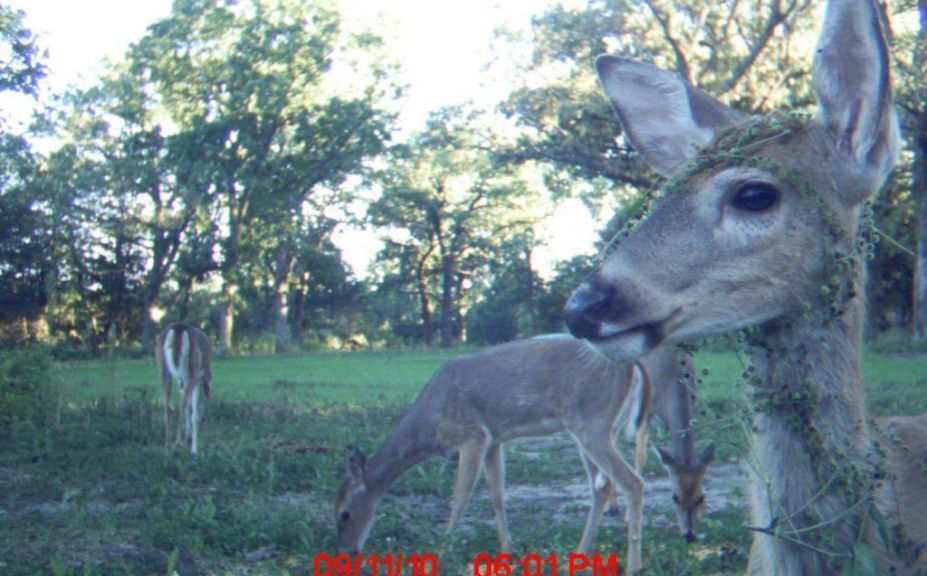
*When you create deer movements, always try to match your habitat improvements to the natural lay of the land. For more tips on creating natural deer movements read, "Natural Habitat and Hunting Designs" .
2. do your deer movement patterns include bucks.
When you start with food (whether it is on your's or your neighbor's land) and you then offer adjacent doe bedding opportunities, you are one step closer to creating enough space for buck bedding opportunities. Within mixed agricultural regions, a typical complete deer movement pattern can be 600 yards or more, including mature buck bedding opportunities. However, depending on the % of cover vs open land (ag lands are typical) the distance of total deer movement pattern will vary greatly. From what I have experienced across the country, the rough, typical movements are as follows:
A. High % Ag Locations -200 yards or less
B. mixed ag regions -400 to 600 yards, c. wilderness setting, -1/2 mile to 1 mile.
However, each of those movements can be reduced to maximize your hunting efficiency. Shorter movements feature a more controlled and defined movement pattern, which allows you as the game manager to take advantage of by more effectively maintaining balanced populations, advancing bucks to the next age class if desired, and improving sex ratios. By leaving much smaller gaps between the beginning and the end of deer movement patterns you can hunt the most compact pattern possible for your area, which includes mature buck bedding opportunity.
The above distances per habitat type, can be typically cut in 1/2 or even better when a landowner is dedicated to creating precision deer movement patterns. Major deer movements (not cover) anchors deer movement patterns, so when you start by leaving enough room for doe bedding opportunity adjacent to consistent food sources, the beginning of a compact movement can be efficiently defined. But what comes at the end of the movement? Mature buck bedding opportunity.
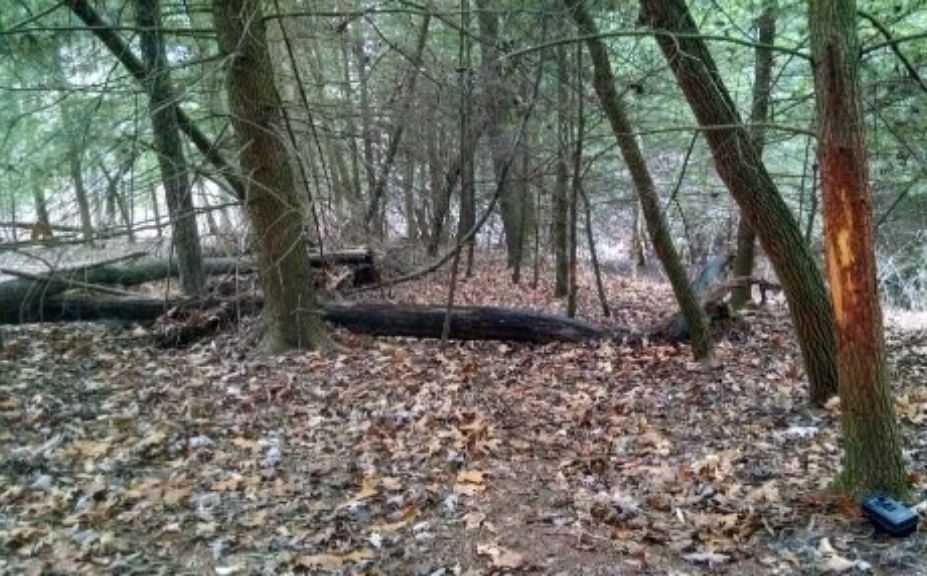
*Do you need some tips for how to find mature buck bedding hotspots? Try reading, "Scouting Deer Bedding Areas" .
3. Mature Buck Bedding Opportunity: The End Of Deer Movement
Although no deer movement can begin without recognizing food based doe family group bedding opportunities, no deer movement can end without established buck bedding opportunities. Think of the entire movement like this:
B. Doe Bedding
C. doe bedding/buck bedding, d. mature buck bedding.
The more compact that you can recognize or create the complete movement pattern relative to the balance of habitat in your region, the greater your potential for herd, habitat and hunting success. It doesn't hurt to find a highly defined an compact deer movement when hunting public land either!
What is "mature buck bedding opportunity"? The same as doe bedding opportunity. I suggest avoiding sizes of deer beds or bedding areas, but instead focusing on locations that match the lay of the land and are conducive to deer bedding opportunity. Decreasing canopy and increasing stem counts of native regeneration of woody and herbacious growth is a great start! Making sure to have a % of conifer, grasses, weeds, briars, shrubs and hardwood regeneration is the "complete package" of deer bedding components for both bucks and does. Finally, making sure that deer can easily move throughout their bedding areas without ducking, diving and jumping is critical no matter where you are located.
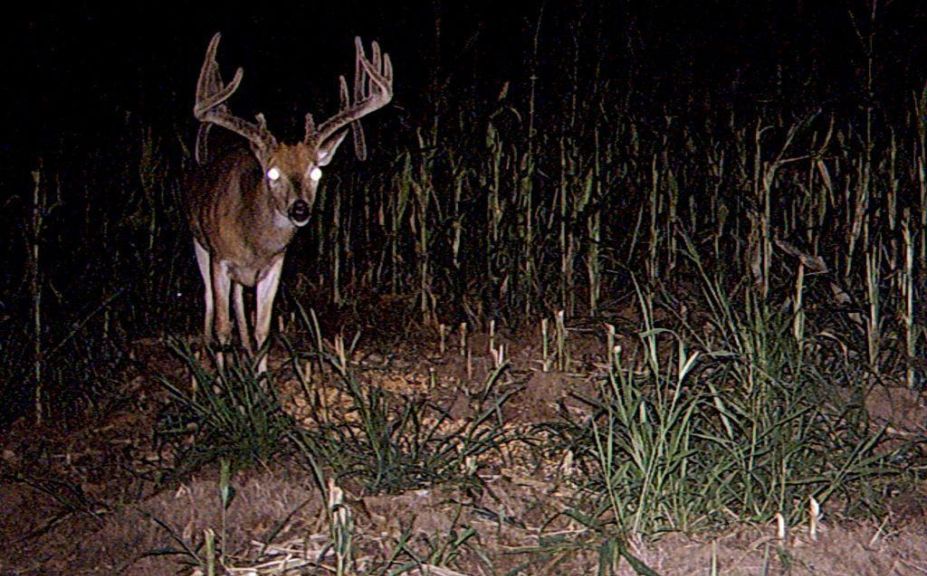
*By far the best mature buck hunting tactic that I have found has been to sneak into a morning treestand on the back side of a buck's bedding area. To read more on this proven strategy, take a look at "Morning Treestand Access Guide" .
Precision Deer Movements Equal Defined Hunting Opportunities
Of course many books can be written regarding hunting tactics, but when hunting a preferred deer movement pattern it boils down to this:
A. Hunt the backside (downwind) edge of the movement during morning hours for bucks, in particular during the first frosty mornings of the pre-rut.
B. Take a stand along side the movement, between bedding opportunities and the evening food source for all day buck cruising activities or afternoon food source movement patterns.
C. Hunt the food source end of the movement during the afternoon, in a stand that allows you to get in and out of the food source without spooking the deer herd.
Maybe that sounds too easy, but when you are in the practice of recognizing highly defined deer movement patterns, the level of your hunting success will be just as defined.
You have an opportunity for a high level of herd, habitat and hunting success when you recognize preferred deer movement patterns. Can you located a preferred deer movement pattern on private or public land? Can you create an efficient deer movement pattern? Can you reduce the total length of deer movement from food source to mature buck bedding? Can you increase the quality of the pieces of the movement, including food sources, travel corridors and bedding areas? You sure can! And that is a collection of incredible opportunities awaiting anyone who steps foot in the whitetail woods.
Related Blogs
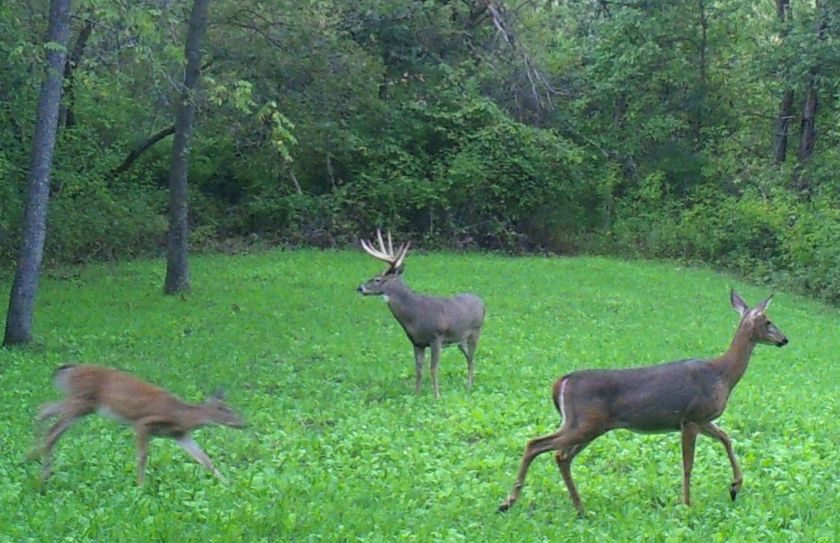
Top 5 Mature Buck Movement Triggers
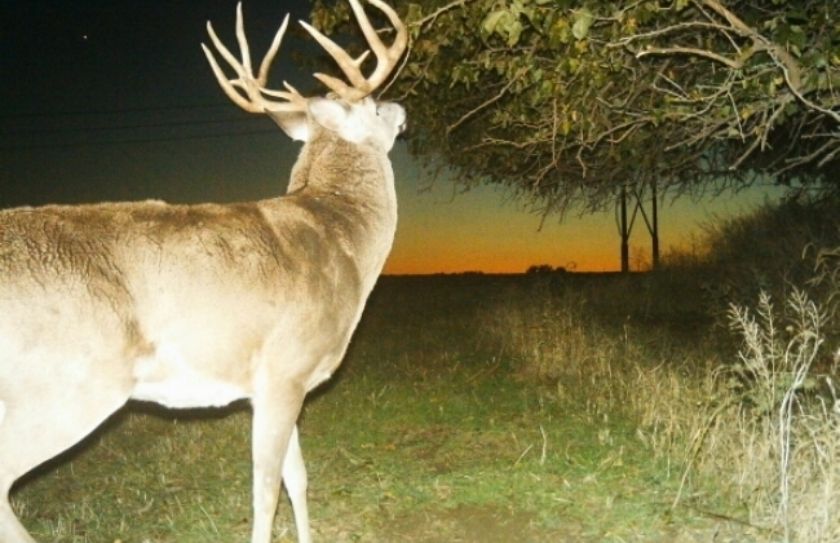
Mock Scrape Strategies: Creating Buck Movement
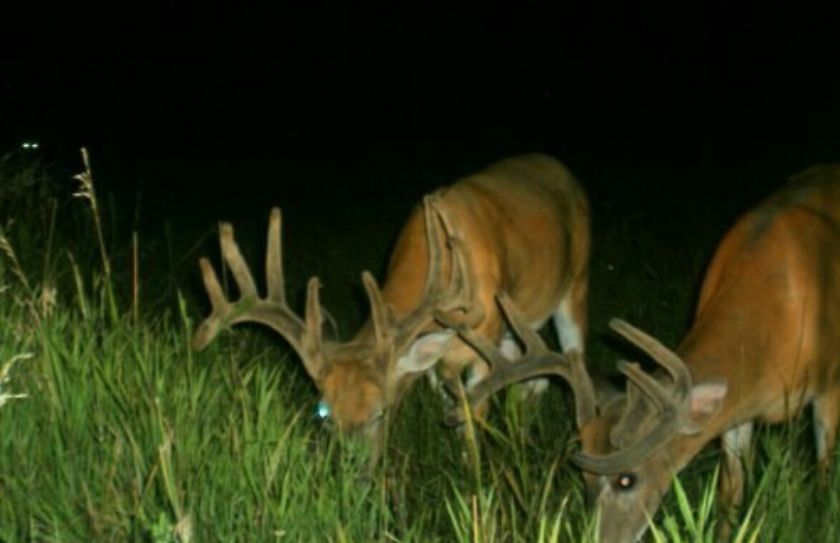
Deer Feeding Times For Monster Bucks
Whitetail success by design book series, revealing “buck of a lifetime” strategies since 2005, camo built for the whitetail woods.
Just in time for Mother's Day, shop our 25 Best Mother's Day Gifts.
FIELD & STREAM+
- Join 1871 Club
Where’d My Buck Go? Whitetail Travels 200 Miles in the Middle of the Rut
Missouri telemetry study reveals the longest trek ever recorded by a non-migrating whitetail deer
By Scott Bestul | Published Jun 14, 2021 4:00 PM EDT

When a buck we’re hunting suddenly disappears, most of us wonder if he’s relocated to another part of the property or, heaven forbid, the neighbor’s.
Well a Missouri buck proved that it’s time to think bigger, people. The Show-Me State buck, a 2-½ year old whitetail known to state researchers as N17003, lit out from his home range and walked 200 miles in just 22 days. That’s the longest trek for a non-migrating whitetail on record, and it beats the previous record by just over 108 miles.
The Buck Averaged More Than 8 Miles a Day
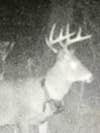
“He took off on October 26, 2017 and was pretty much on the move constantly until December 7,” said Jason Sumners, researcher with the Missouri Department of Conservation (MDC). “He was averaging about 8½ miles a day and, in the process, crossed a major river seven times, an interstate highway, eight state highways, and a railroad. It’s a miracle he wasn’t hit by a vehicle, as almost all the movement was at night, which is rarely good for deer crossing roads.”
But it wasn’t just vehicles this buck avoided, as his journey took place in the heart of the Missouri firearms deer season. “We think the buck likely started moving in response to the upcoming rut,” Sumners said. “But a big chunk of his activity occurred between November 11-18, during our rifle season. We’re speculating, of course, but it seems likely the buck just couldn’t find a block of cover where he felt safe. So he just kept going. He spent one night in a outside the town of Bethany in about the only wooded cover for miles.”
Buck Was Likely Seeking Security Cover During Gun Season
Sumners felt that cover and topography likely contributed to the long walkabout. “This is largely ag-country, with small blocks of timber breaking up big farm fields,” he said. “Generally, deer living in more forested habitat, like we have in southern Missouri, just move less; they don’t have to travel far to find the cover or food they need. And it’s interesting; if this buck had moved in just a slightly different direction, he’d have run into more wooded areas. Would he have stopped? We can’t say, because the path he took led him into more open country. ”
Modern telemetry allowed researchers to keep tabs on a deer they would have lost otherwise, Sumners said. “Not long ago we’d have just been driving around, hoping to pick him up with an antenna (signal) and he’d have walked out of our study. But GPS allowed us to (pinpoint) deer every day.
Of the 600 animals in this telemetry study, Sumners said this one certainly stood out. “But who knows?” he adds. “Maybe he hints at more.”

Trained as a high school English teacher and coach, Scott Bestul left that lucrative field to pursue another—as a full-time freelance writer in 1990. He sold his first story to Field & Stream a few years later and has been contributing to the brand ever since.

Regional Strut Update
Live updates from our turkey experts in each region
More Articles From Whitetail
Understanding whitetail activity and movement yields better deer hunting success, having good whitetail hunting land will only get hunters so far; studying what triggers deer movement and identifying hot spots for deer activity are just as important.
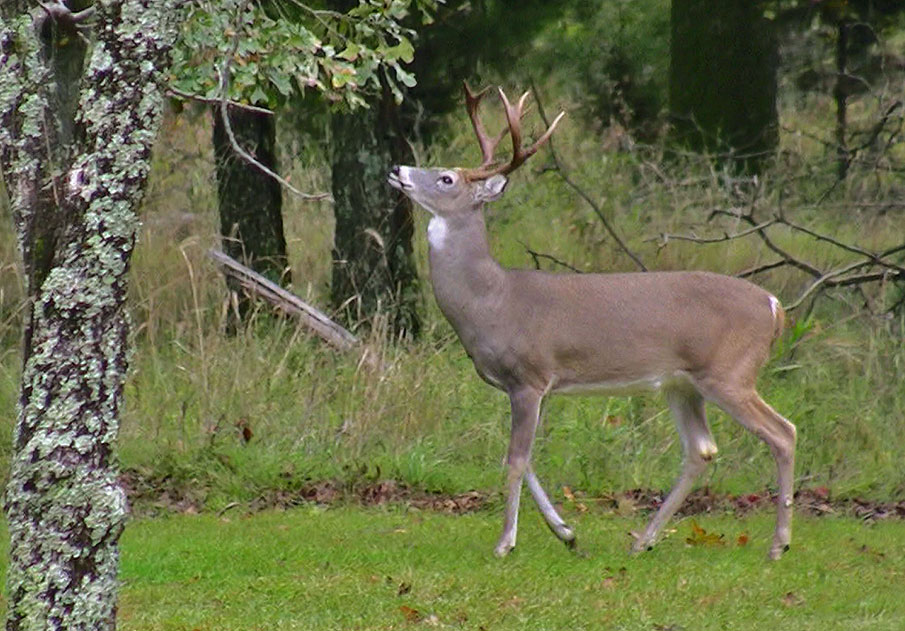
One of the most important components of successful whitetail hunting is patterning animal movements. The hunter must determine when deer are most active and how they're using different habitat types at different times.
Understanding deer activity starts by looking into home range, defined as the area used by a deer during the normal daily activities of eating, mating and raising young. Whitetail home ranges vary drastically based on many factors and can range from 250 to 2,500 acres.
Typically, areas with a consistent mix of food, cover and water lead to smaller home ranges. Deer are faithful to seasonal home ranges across the years, and females have a particular affinity for traditional home ranges, with does often using the same or adjacent areas as their mothers or other female relatives.
Most bucks disperse from their home range of birth and establish new home ranges, but afterward they show fidelity to the new home range.
Home range can change seasonally as a result of habitat availability. For example, one Nebraska study showed a shift in the center of a whitetail's home range of 174 meters closer to corn fields when corn was in the tasseling and silking stage, and a shift 157 meters away from the corn field after harvest, when range size increased by almost a third.
Within home ranges, many factors influence whitetail activity, including time of day, an animal's age and sex, the time of year and the weather. Still, numerous studies - and the observations of countless hunters over the ages - show that whitetail activity generally peaks at dawn and dusk.
Sunset seems to be the period of greatest activity, while times of lowest activity take place during the predawn early morning, late morning and late evening after sunset. Some studies have reported a distinct dawn-and-dusk pattern during some seasons and a lack of any pattern - or a shift to a single peak - in other seasons. Other evidence points to minor peaks at midday and midnight.
It shouldn't be a surprise that all these generalizations about activity don't always hold true, and that activity patterns vary widely within individual animals and also change as a result of factors such as predators, food availability and reproduction.
Speaking of reproduction, a whitetail's sex affects its daily activity patterns. For instance, although daily patterns usually are similar between bucks and does, patterns change in early autumn, when bucks are more active than does at night, and does are more active than bucks during daytime hours.
Research also illustrates distinct seasonal differences between the sexes as a result of herd social structure, reproductive behavior, gestation and lactation activities and region. On average, females are active 1 1/2 hours per day longer than males between January and July, and they also spend more time in heavy cover.
Demands of pregnancy and lactation require a high-quality diet that necessitates an increase in foraging activities. In northern areas, deer move less during winter and shift to more daytime activity as a response to lower temperatures. In southern Texas, the greatest activity occurs in January and again in September-October, while in southern Michigan, the greatest activity takes place during May and October, with lowest activity during midwinter.
Although it's no secret that weather plays a role in deer activity, research shows that temperature may have the biggest impact across all four seasons. In one study, deer observations during spotlight counts were directly related to temperature and negatively correlated with cloud cover, precipitation and dew.
In a Michigan study, deer activity rates during spring, summer and autumn were greatest between 50 degrees and 61 degrees, with activity rates declining in direct response to temperatures above or below that range. Responses to temperature are probably different in more southerly latitudes.
In an Oklahoma study, bucks during winter moved more when temperatures were lowest, while females during summer moved greater distances when temperatures were normal to high and less when temperatures were coolest.
Although it's considered an important factor among hunters, wind seems to have very little effect on whitetail activity. It's important to note, however, that deer do tend to seek out sheltered areas that reduce wind speed on blustery days (this is especially true during winter).
Movement in response to precipitation is unpredictable, although it has been reported that deer are often less active during heavy rainfall or during snowstorms with high wind.
The moon's effect on deer movements is a common subject around deer camps and coffee shops where hunters gather, and unfortunately, many questions remain.
A pair of research projects from the 1970s pointed to some potential effects caused by the moon, with one study reporting increased movements during both day and night around the time of the full moon, and the other observing increased use of open habitats on moonlit nights. Most research, however, has found little or no effect of moon phase or moonlight on whitetail activity.
The breeding season can affect activity, which likely isn't any surprise to deer hunters. But there's science to back up what we've all seen through the years. This particular change in activity typically manifests in the form of unusual short-term movements outside of a deer's home range. Two studies reported that more than half of their research bucks made excursions outside their home ranges during breeding season, movements that were assumed to be the result of either a search for receptive females or a buck's tending to estrous does as the does moved back to their core areas.
A final facet of deer movement that can't be overlooked is dispersal. Dispersal is defined as the permanent movement from home range of birth to a new home range. It's a common behavior of many vertebrates and is likely a mechanism to avoid inbreeding.
As mentioned previously, does tend to stay in or near where they were born, while young bucks typically move out of their birth area. Radio telemetry has shown that most dispersal takes place among yearling bucks. Other research has shown dispersal rates in bucks as high as 70 percent.
The nature of a whitetail's habitat plays a part in the distance of dispersal, with bucks moving farther from their birthplace range in open or fragmented habitats. For example, bucks in Midwestern U.S. agricultural areas have been shown to disperse more than 25 miles from their original range.
Although it seems obvious that whitetails, like many mammals, are hard-wired to disperse so they enhance genetic diversity, we know less about the actual behavioral stimulus that triggers dispersal. Because there are differences in the timing of dispersal, two hypotheses have emerged.
Social pressure from other bucks or competition for mates may be one cue for young bucks to disperse, a scenario that is evidenced by dispersal that takes place prior to the autumn rut. Social pressure from female relatives may represent another dispersal cue, in which case the dispersal takes place during springtime.
It's not breaking news that deer spend a lot of time on the move. But understanding the reasons behind their movements can increase our chances of being in the right place at the right time to make sure they cross our paths.
For video of Michael Waddell's study of a whitetail, click here .
GET THE NEWSLETTER Join the List and Never Miss a Thing.

GET THE MAGAZINE Subscribe & Save
Digital Now Included!
SUBSCRIBE NOW
Give a Gift | Subscriber Services
PREVIEW THIS MONTH'S ISSUE
Buy Digital Single Issues
Don't miss an issue. Buy single digital issue for your phone or tablet.
Other magazines.

Guns & Ammo

North American Whitetail

See All Other Magazines
Special Interest Magazines

2023 Backcountry Hunter Fall

2023 Fly Fisherman Destinations

2023 Crossbow Revolution #2

2023 Tree Saddle Hunter

2023 Hunting Gear Guide
See All Special Interest Magazines
More You May Be Interested In

Get the top Game & Fish stories delivered right to your inbox every week.

Get Digital Access.
All Game & Fish subscribers now have digital access to their magazine content. This means you have the option to read your magazine on most popular phones and tablets.
To get started, click the link below to visit mymagnow.com and learn how to access your digital magazine.
Get Digital Access
Not a Subscriber?
Enjoying What You're Reading?
Get a Full Year of Guns & Ammo & Digital Access.
Offer only for new subscribers.
Subscribe Now
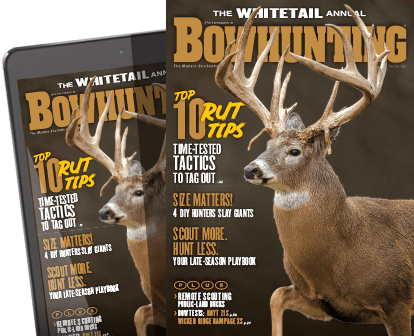
Get The Magazine
Subscribe & Save.
Digital Now Included!
How Far Do Bucks Really Travel During the Rut?
Throughout the summer and early fall, I'd used half a dozen trail cameras to pattern an impressive 9-pointer. But suddenly the deer is nowhere to be found. After hunting the same spot for three straight days, I figured the buck had probably left my property looking for estrus does.
Last night, a torrential downpour flooded the path to my favorite stand. So rather than plod through the mess, I opted for a different stand. At the end of the morning hunt, I stopped by my favorite stand to pull the memory card from a nearby camera. An hour later, near-horror struck me: several photos showed the buck I'd coveted standing about 20 yards from my stand.
I'd given up on my best hunting spot and it cost me. A lot of hunters would have made the same mistake. Many assume that once the rut kicks in, a buck can be found anywhere. Hunters also think that mature rutting bucks travel much more than their younger brethren in search of mates. But the latest research on deer movement is calling into question these long-standing beliefs .
Let's look at what scientists have discovered about how far bucks travel during the rut and how to use that insight to increase your odds of bagging mature bucks.
A Mass Exodus?
Many bowhunters consider the rut to be the best time to deer hunt. Increased testosterone causes bucks to increase their activity to find estrus females, making them vulnerable to a hunter's arrow. The likelihood that hunters will see a buck they've never seen before also increases during the rut.
Former graduate student Justin Thayer and Louisiana State University professor Michael Chamberlin captured and placed radio telemetry collars on 37 bucks that lived in a bottomland hardwood forest in south central Louisiana. The area was managed by several hunt clubs whose members all agreed not to shoot bucks with fewer than 8 points.
Video That May Interest You
On average, Thayer and Chamberlin found that bucks maintained home ranges smaller than 400 acres! Both adult (2€‰1„2 years old and older) and yearling bucks maintained the largest home ranges not in the fall when the rut occurs, but in the spring. They rarely ventured outside their home range during breeding season.
"Hunters would tell us that they knew bucks were around, but they just weren't seeing them," said Thayer, now a biologist for the Mississippi Department of Wildlife, Fisheries and Parks . "We'd often find a buck bedded down in heavy cover less than 50 yards from a hunter's blind."
Thayer believes that quality habitat explains why bucks stay on a property.
Recommended
"Position your stands to always play the wind and so you can enter and exit without disturbing deer," Thayer added. "If you're late getting to your stand in the morning, go in an hour after it gets light. Do whatever you can to avoid bumping deer."
Brief Holidays
Radio telemetry technology only allowed Thayer to check on each buck's whereabouts several times a week. Graduate student Gabriel Karns placed GPS tracking collars on adult bucks living at Chesapeake Farms, a large agricultural research area in Maryland. Karns was able to take a GPS reading of each buck every 10 minutes to see if deer went on excursions, defined as movements lasting a minimum of six hours and venturing at least a half-mile from their home range.
Karns found that only 63 percent of all bucks monitored made an excursion, and 59 percent of them did so around breeding season. On average, bucks that took excursions during breeding time were only gone for 10.5 hours, and only 59 percent of them traveled during daylight hours.
"In one area, there was a small creek running through a large cornfield," explained Karns. "One buck in our study stayed on 40 acres for three straight months."
For years, biologists and students from the Caesar Kleberg Wildlife Research Institute at Texas A&M University — Kingsville have been tracking the movements of different groups of bucks on the King Ranch in South Texas . To date, more than 100 bucks have been fitted with GPS collars and closely monitored. Each one wears its collar for about six months, giving biologists 3,000-5,000 observation points.
Researchers have learned that when it comes to adult buck travel patterns around breeding season, there is no pattern.
"Bucks are individuals with different personalities, so you can't say age influences the size of bucks' home ranges, how often they move or how far they travel during the rut," said biologist Mickey Hellickson.
All King Ranch bucks took at least one rut-excursion but were gone only one or two days. Former doctoral student Aaron Foley found it impossible to predict how long bucks would be gone on excursions.
"Excursion characteristics were variable," said Foley, now an ecologist for the U.S. Geological Survey . "Some were brief trips outside of home ranges, while some were clearly exploratory trips."
In other words, bucks didn't have any consistent pattern in how far they roamed, or even in why they roamed. This is consistent with what biologist and Quality Deer Management certification manager Matt Ross found when he analyzed the past 15 years worth of research on buck movement.
"Numerous studies have shown that a buck's home range size is highly variable and not strongly correlated to age, daily movements or any number of factors," said Ross. "Mature bucks are not clones of one another, and many display more individualistic behavior than what was previously thought."
Ross also notes that bucks use less of their home range during breeding time.
If you're going to target a specific buck, be relentless in your pursuit. Hunt the deer hard for several days, because there's a good chance the buck you're after will swing by your stand. Foley agrees.
"Because excursions typically only occurred two or three times per buck, bucks spend the vast majority of their time within their home ranges," added Foley. "Hunters that are familiar with a particular buck should spend as much time as possible within his home range — a sudden disappearance does not imply the buck is gone for good."
Two Residencies
Now for the bad news: the Chesapeake Farms and King Ranch studies have found that some bucks had two distinct home ranges. About 20 percent of King Ranch bucks had one home range during the rut and another the buck traveled to after breeding season. It's possible that the buck you're trying to harvest has two homes — and only one of them is where you hunt.
So, you need to decide if targeting only one buck throughout the season is worth it. If you play the odds, then stay put, as most bucks have only one home range. But if the buck you're after suddenly disappears and is gone for several days, it may have permanently relocated.
But take heart, because the research also suggests that as bucks age, they're less likely to leave or change where they live. This is particularly true if deer have quality habitat on your property. Like the other researchers, Ross firmly believes that providing ample food and cover goes a long way toward keeping all deer on your property, including bucks.
Finally, it bears repeating that bucks are unique creatures with different personalities . Some will be homebodies, while others will put miles under their hooves looking for estrus does. Spend some time before deer season figuring out the personality and preferences of the buck you'll be hunting.
Are most of your photos of the deer taken at night? Are you getting pictures of the same buck at many different locations on your property? Do you get a lot of pictures of the buck for several days and then it seems to disappear?
Answer these questions and you'll better understand the buck you're drooling over, helping you put an arrow through it come fall.
Follow the Corn

Watch the Weather

Don't Overhunt

Late-Season Doe

Persistence is Key

Change the Location of Your Stand

GET THE NEWSLETTER Join the List and Never Miss a Thing.
Recommended articles.

New Bow Accessories for 2022
Jon E. Silks
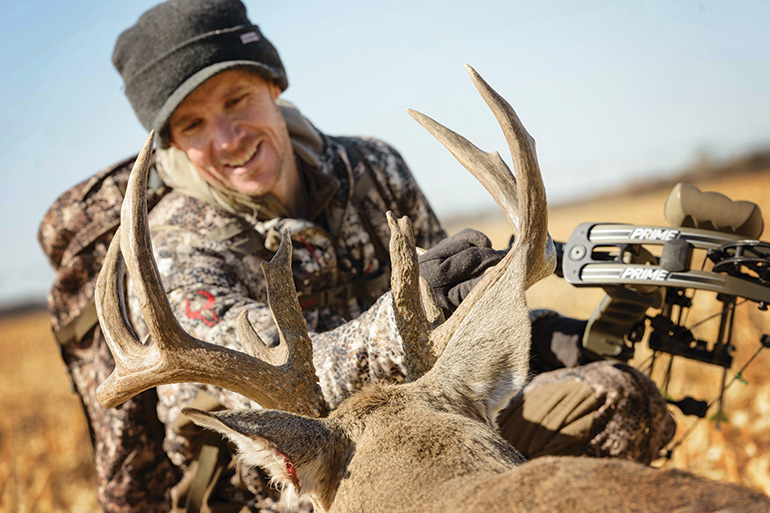
10 Land Management Strategies for Small Whitetail Properties
Jace Bauserman

New Broadheads for 2022
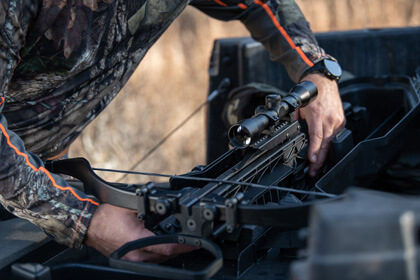
Excalibur Rolls Out 2022 Crossbow Lineup
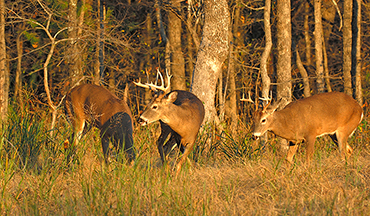
New Deer Management Study: Small-Antlered Bucks & Stump Sprouts
Jason Snavely
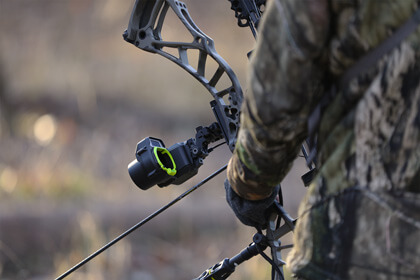
New Bow Sights & Arrow Rests for 2022

New Optics & Scouting Gear for 2022
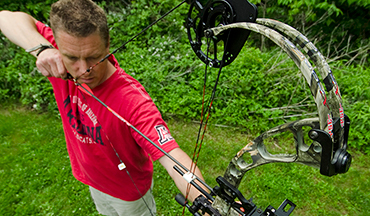
Untunable Bow? Nock Travel Could Be Your Problem
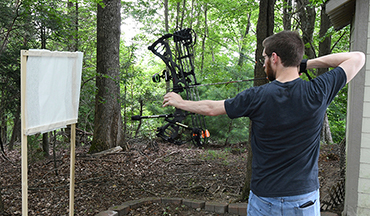
How to Paper Tune a Bow
Patrick Meitin

New Bows for 2022
Christian Berg

Goof-Proof Tips For Sighting-In Your Bow
Recent videos.
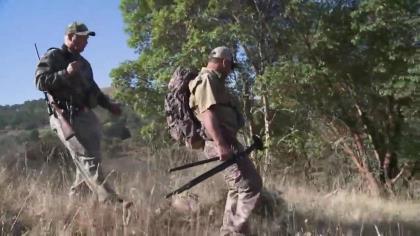
A Missed Whitetail Opportunity
Craig Boddington and Ron Coburn of Savage Arms have an unfortunate situation as they are in search of a unique whitetail sub-species along Oregon's Columbia River.

The Origins of Boone & Crockett
Craig Boddington gives a quick summation of why the B&C club was created and the role it's played in conservation efforts dating back to 1888.

GET THE MAGAZINE Subscribe & Save
SUBSCRIBE NOW
Give a Gift | Subscriber Services
PREVIEW THIS MONTH'S ISSUE
Buy Digital Single Issues
Don't miss an issue. Buy single digital issue for your phone or tablet.
Other magazines.

Guns & Ammo

North American Whitetail

See All Other Magazines
Special Interest Magazines

2023 Backcountry Hunter Fall

2023 Crossbow Revolution #2

2023 Tree Saddle Hunter

2023 Hunting Gear Guide


2023 Public Land Hunter
See All Special Interest Magazines
More You May Be Interested In

Get the top Petersen's Bowhunting stories delivered right to your inbox.

Get Digital Access.
All Petersen's Bowhunting subscribers now have digital access to their magazine content. This means you have the option to read your magazine on most popular phones and tablets.
To get started, click the link below to visit mymagnow.com and learn how to access your digital magazine.
Get Digital Access
Not a Subscriber?
Enjoying What You're Reading?
Get a Full Year of Guns & Ammo & Digital Access.
Offer only for new subscribers.
Subscribe Now

Get The Magazine
Subscribe & Save.
Digital Now Included!
What You Need to Know About Whitetail Home Ranges
I walked into the fertilizer company's office just in time to hear the radio crackle, "Bernie, are you there yet?"
I was showing up for work just after daylight that mid-November morning in 1989, and my boss was already asking for me on the radio. But when I answered, the call took on a whole new meaning.
"I'm by the slough on the southeast end of Paul Johnson's home place. GET DOWN HERE NOW!"
Jerry was also my bowhunting buddy, and I knew what the call meant. It's illegal to share hunting information over the radio, but I could tell by the urgency in his voice that this call wasn't exactly work-related.
Jerry often showed up for work late at that time of year because he spent a couple hours each morning glassing the surrounding farmland for bucks that had pushed does out into the open fields. This morning, he needed help — and I was happy to oblige.
Ten minutes later I skidded to a stop next to his vehicle on the gravel road. With our windows down, he excitedly related what had prompted his radio call.
A "huge," "giant," "monster," "unbelievable" buck had seen Jerry's truck top the hill and had dived into tall cattails and willows, disappearing into the 1-acre slough. The buck was still in there, and Jerry was going in after him. My boss would give me a few minutes to work around and choose an escape route to cover in case anything went wrong with his stalk.
Taking note of the wind direction and assuming the buck would try to sneak out with the wind in his nose, 10 minutes later I was covering a deer trail on the opposite side of the small patch of cover. Jerry began creeping in. Arrow nocked, release on the string, I was ready. I still hadn't seen the buck, but Jerry and I had hunted a lot of these northern Iowa bucks in similar situations, and I could tell by his wide-eye description of the deer that this wasn't just another 150.
Video That May Interest You
Moments later, I heard Jerry yell. I stood up just in time to see the buck escape the far side of the cover and run across the field. I got a good, long look at him as he ran through the CRP field and over the crest of a hill. And what I saw defied description.
To this day, the sight of that buck is etched in my memory. In 45 years of bowhunting, I've never seen anything else like him. His rack was twice as wide as his butt. It reached for the sky, and my first thought was that he had a rocking chair on his head. Stickers and kickers and drop tines: this buck had it all.
Despite spending the remainder of that day and many hours over the following weeks and even years trying to locate the buck, we never saw him again. We never heard of him being killed. We never even heard of anyone else around there having seen him.
Recommended
So, to our knowledge he was never killed. When we'd look at replicas of world- and state-record bucks , including the giant 282-inch Raveling buck at the Iowa Deer Classic, Jerry and I would just shake our heads and sigh.
Where did that giant we saw come from? Where did he go? How does a world-class buck just appear out of nowhere — and then disappear just as mysteriously?
An Old Theory Revisited
In 1993, Tom Miranda and I teamed up to write a book called Corn Fed Giants. In it, we offered a lot of information for the farmland whitetail hunter. Among the topics I wrote about in the book is a phenomenon I've not seen in print anywhere else.
I wrote of my belief that once an outsized, genetically superior buck gets big and strong enough to beat up every other buck he contacts, he just goes wherever he wants during the rut. He breeds does as he pleases, traveling far and wide if need be in that quest. He might follow long-running travel corridors for miles and miles. Then, when the rut is over, he might return to his original range — or, he might settle down right where he is, in the best available habitat.
When I announced that theory over 20 years ago, researchers' ability to track wild bucks' movements wasn't what it is today. Now, with GPS collars, a lot more has been learned about travel patterns and home ranges. Even so, I don't believe there's been any research to back up my theory.
In fact, most research has shown bucks tend to reduce their home ranges they mature , particularly after passing peak breeding age. But I'm not totally ready to give up on trying to explain the issue of bucks that appear and disappear like ghosts.
One thing we've learned is that bucks are individuals with their own "personalities." And to my knowledge, no one has put a tracking collar on a wild, world-class buck in Midwest farmland habitat. I've seen too many situations in which a huge buck just showed up on a camera, never seen before and then never shot or even seen again. Nor is either of his shed antlers found. It's as if he simply appeared out of thin air . . . and then vanished in the same fashion.
What does this mean to the hunter who wants to know more about the home ranges and travel patterns of mature whitetails? And furthermore, is there information out there to help us improve our odds of bringing such deer home with us?
Defining Home Range
Every deer hunter has heard the term "home range." It's usually associated with a number of acres or square miles. The numbers vary greatly by terrain, habitat quality, food availability and time of year.
Home ranges of whitetail bucks in excellent habitat with plenty of food available can be quite small. GPS studies in prime areas of Louisiana, Pennsylvania and Maryland have shown home ranges averaging from 269 to 559 acres; not even as much as a square mile (640 acres).
Often a square mile is used as a baseline for a buck's home range in good habitat, though there are clearly many places in which that figure is way off. A GPS tracking study in Texas showed an average home range of 2,271 acres. Availability of food and proximity to cover make all the difference.
In many parts of the West, in fact, whitetails routinely make treks of 2-3 miles between preferred bedding areas in timbered hills to feed on alfalfa in the lowlands. The deer make that long-distance hike each way daily. It's hard to put a number of acres on a home range when deer are taking such long strolls.
Putting a number of acres or square miles on a home range is deceiving, because it almost implies the area is something of a circle or square. In reality, a home range might be a section of winding river bottom two miles long by 300 yards wide. It might include a couple areas where the deer move upstream on a small tributary, which further makes putting a number on it difficult. The shape of a deer's home range is dictated by habitat, not by acres.
It can be a mistake to get caught up in home ranges when targeting a particular deer. Trail cameras can help you get a feel for where the buck is spending the majority of his time and when he's there, but trying to determine the boundaries of his preferred area can be futile.
Bucks will go wherever they need to go to get food and water daily, and they'll certainly roam during the rut. Home ranges are very fluid and dynamic.
While an overall home range might be pretty nebulous, a core area isn't. The Quality Deer Management Association defines a core area as "The portion of a buck's home range where he spends 50 percent of his time." Core areas are all about security and comfort. While a buck might range widely to find food and water, he'll often come back to the same small area in which he feels secure.
These core areas can change due to weather and food availability. If a food source completely runs out, and there's suitable bedding cover near a new food source, the buck might pack up and move.
Bucks also tend to bed in the thickest, nastiest cover during bad weather, though they tend to select areas with some visibility during pleasant weather. A buck might use three or four core areas during the course of any given year.
On average, mature bucks tend to have smaller core areas than younger bucks. The 2 1/2-year-olds travel widely, having ranges much larger than even 3 1/2-year-olds.
Many bucks 5 1/2 or older have tiny core areas in which they've learned they can feel secure. These deer are big enough to take over the best of the best bits of security cover from other bucks if they so desire.
The ability to track bucks' exact whereabouts with GPS technology has opened a whole new world of information about their habits. One of the things learned through these studies is that bucks, especially mature bucks, take off on what biologists have termed "excursions" a few times per year. The GPS collars have shown these to be anywhere from one to four miles from the core area.
These trips often last around three days. It's no stretch, considering the individuality of bucks, to suggest some are far longer. The "stranger" that just showed up on your camera might be on just such an excursion.
While the rut is one time in which bucks make excursions, it isn't the only one. Spring also is "vacation time" for many bucks. In a GPS study done in Pennsylvania by the University of Georgia's Andy Olson, all 19 collared bucks went on spring excursions.
It's not fully known what triggers such forays, but some likely are the result of nutritional needs as antlers are beginning to grow. This also is the time when many bucks approaching their first birthdays are traveling around, looking for adult home ranges of their own.
Fall excursions might be related to rutting behavior or even hunting pressure . The collared bucks in these studies were quick to go entirely nocturnal when they felt hunting pressure or other human intrusion. Pressure even can cause bucks to leave their home ranges altogether for long periods of time.
Secondary Ranges
Following buck movements by GPS makes it clear most bucks have a backup plan: a secondary home range they'll move to as needed. This is evidenced by the fact they tend to go directly to new areas and spend a lot of time there, indicating prior knowledge of those places.
I have no way of proving this, but I theorize these secondary ranges are often bucks' natal areas. A buck spends the first year of life in his mother's home range, learning it intimately. It stands to reason that if an adult buck is making a beeline to an area he knows well, it's possibly one he learned as a fawn.
I suppose the only real way to prove or disprove my theory would be to put a GPS collar on a wild buck fawn and track him over several years. To my knowledge, this hasn't yet been done.
In Conclusion
Keep in mind that only a relatively small number of wild bucks have been collared and tracked for lengthy periods. This leaves us with very general tendencies and few specifics.
Again, bucks are individuals; they often have remarkably different habits and personalities. Add to that the fact no truly giant wild bucks have been collared. They might behave quite differently from run-of-the-mill bucks.
I've resigned myself to never knowing where that giant non-typical Jerry and I saw in 1989 came from or went. I'm sure he wasn't shot by legal means, or we'd have heard. He probably just died an "old man," as many smart bucks do. But GPS tracking studies continue to offer new insights into whitetail movements and ranges.
Maybe one day a world-class nomad like him will be collared and we'll all get a look into the secretive lives of such giants. No doubt it would be revealing.
GET THE NEWSLETTER Join the List and Never Miss a Thing.
Recommended articles.
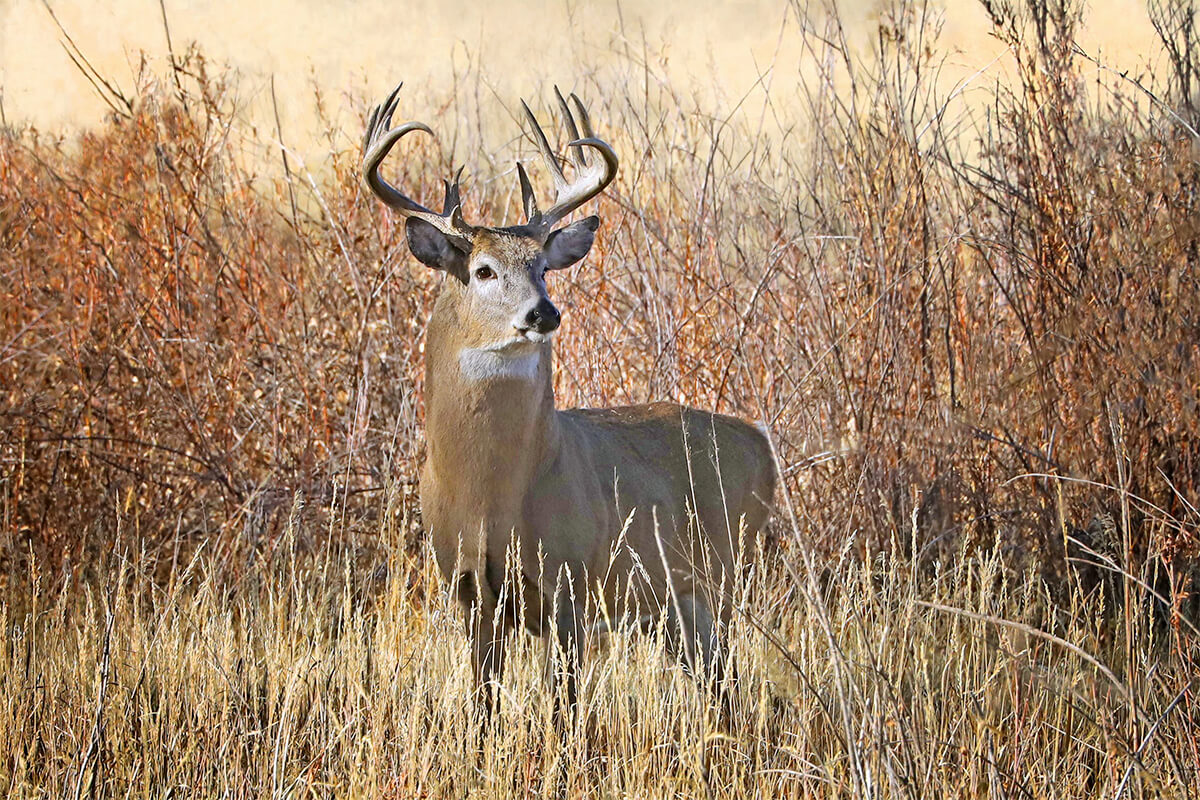
How to Create an ‘Invisible Fence' Around Your Property to Hold More Bucks
Don Higgins
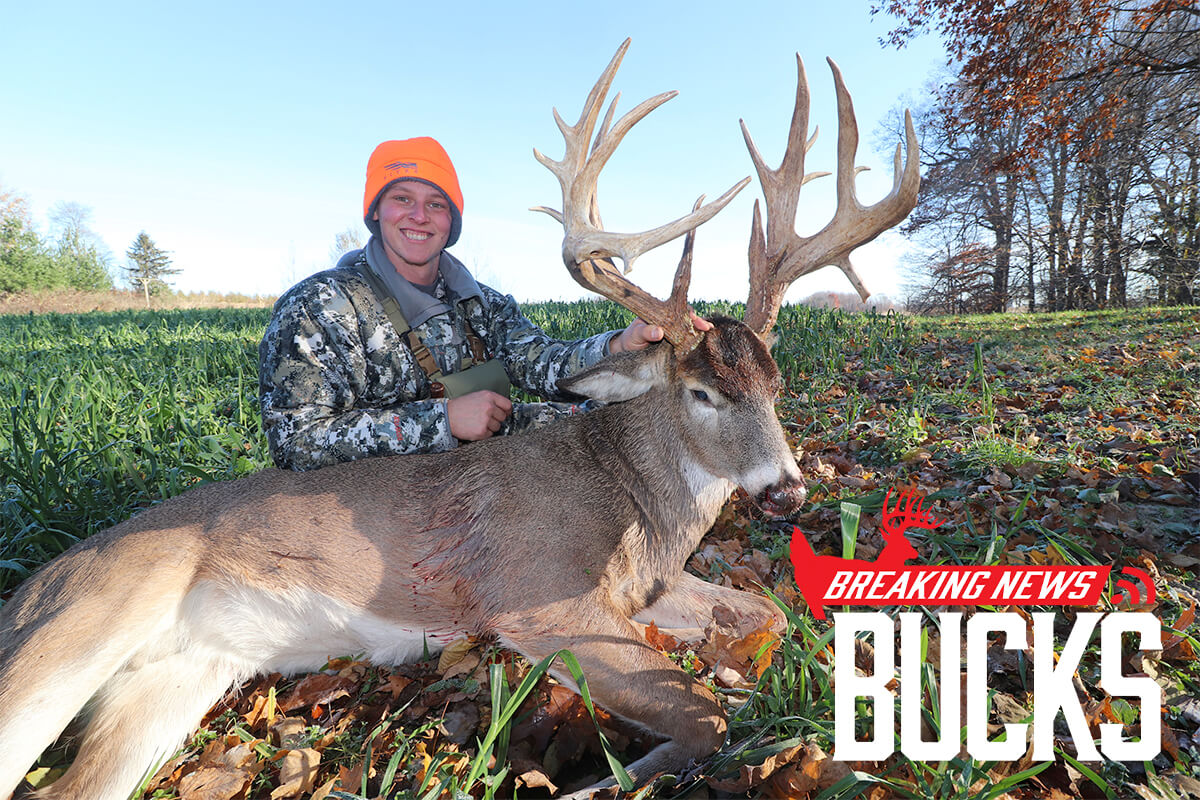
Michigan Hunter Shoots 200-class Non-typical After Oversleeping That Morning
Gregory Shembarger

What Happened to the 2021 Rut?
Dr. James C. Kroll

Iowa Bowhunter Goes Stealth Mode with a Tree Saddle to Bag 194-inch Non-typical
Aiden Ruble
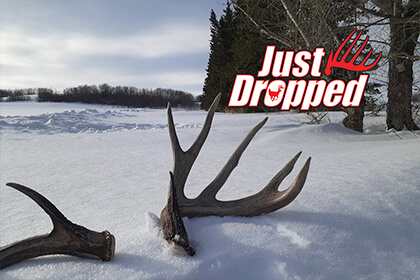
Saskatchewan Hunter Finds Target Sheds After Looking for Multiple Days
Blake Garlock
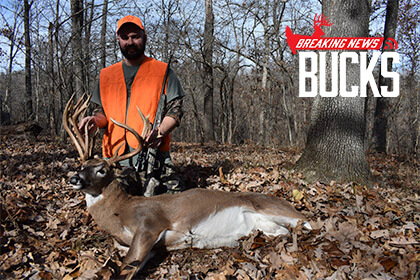
Missouri Hunter Shoots 25-point Ozark Giant with Limited Time to Hunt
Tony Kalna Jr.

How to Find Big Buck Sanctuaries in the Spring

Potential Kentucky State Record Crossbow Typical Shot in Hemp Field
Hunter Schmittou
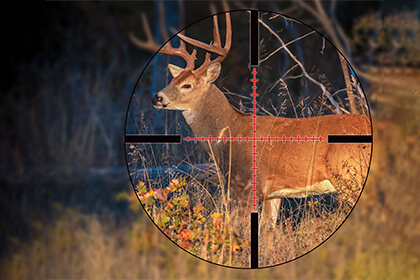
A Whitetail Hunter's Guide to Ballistic Reticles
Haynes Shelton
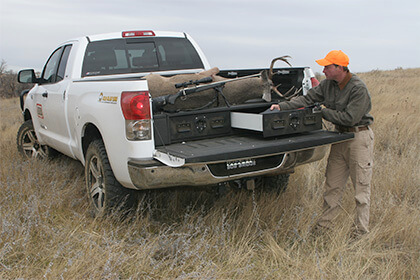
Hunters Must Lead the Fight Against Invasive Species
Mark Kayser

Night Hunting for Predators Will Help Your Deer Herd
Recent videos.

Ripcord Arrow Rests Rejuvenates Lineup with Three New Models
One of bowhunting's most important accessories is the arrow rest, a key component to achieving deadly accurate arrow flight when Mr. Big is only 25-yards away and turned broadside for just a moment. And as Pure Archery Group's Todd Snader tells North American Whitetail magazine editor and television show host Haynes Shelton, the three models of Ripcord Arrow Rests' rejuvenated lineup for 2024 deliver amazingly accurate shots downrange, whether that's into the 10-ring of a summertime 3-D target or the boiler room of a mature buck moving through the woods in November.

Don't Sleep on Conventional Trail Cameras
Dale Evans is at the Browning Trail Camera booth during the ATA show to look at the new offerings for 2024. If you hunt in a state that doesn't allow cellular trail cameras, then these new SD card exclusive cameras from Browning are your best bet. Offering new lens that have been perfectly tuned for day and night photos, these are some of the best cameras we've ever seen.

Browning Trail Cameras Announces Cellular Innovation for 2024
North American Whitetail Associate Editor Blake Garlock talks Browning cell camera innovation with Tom Rainey at the ATA show. Blake and Tom discuss Browning Trail Cameras' new-for-2024 “All HD All the Time” technology, which means Browning cellular camera users no longer have to request HD photos from the app. This and more new features place Browning at the top of the trail camera industry for 2024.

ATA 2024 Core SR First Look from Bowtech
To celebrate 25 years, Haynes Shelton tours the new Core SR Compound Bow from Bowtech with Todd Snader.

Browning OVIX Camo: Ultimate Concealment for Any Time, Any Place
Browning's OVIX camouflage is your complete concealment solution for every hunting scenario, from rocky terrain to tree stands, and from bugling bulls to grunting whitetails.

Air Venturi Avenge-X Classic PCP Air Rifle Reviewed
The Avenge-X offers a level of modularity never experienced with PCP air rifles, making it the perfect all-purpose pellet rifle for hunters and shooters. Renowned outdoor writer Brad Fitzpatrick gives an in-depth review.
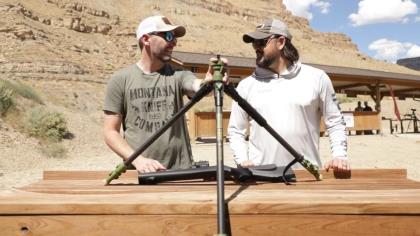
Primos Edge Carbon Fiber Tripod Shooting Sticks
Dale Evans is joined by Matt Rice to discuss the all-new Edge Carbon Fiber Tripod from Primos. The Edge is light, stable, and highly versatile – it's everything you've ever wanted in a shooting stick. Featuring a MagnaSwitch Mounting System with Spartan Precision Technology, it allows shooters to connect their tripod quickly for fast, accurate shots.
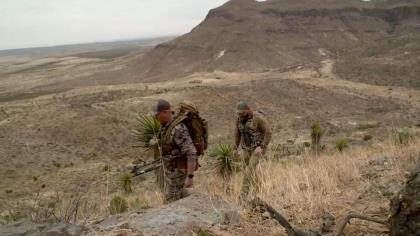
Bowhunting Aoudad in Texas with Browning OVIX Camo
Danny Farris puts his Browning OVIX camouflage to use in the rocky terrain of Texas.
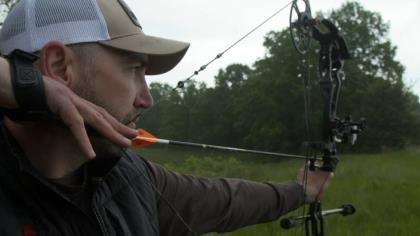
Bowtech CP30: A Better Bow Made For The Whitetailer
Digital Editor, Dale Evans walks you through the features of the new for 2023 Bowtech CP30. With a short axle-to-axle, the CP30 is perfect for the tree stand or ground blind. Available in many different color options, a wide array of draw lengths and weights, and boasting an IBO speed of 331 FPS; this bow can do it all. It truly gives you extreme maneuverability with maximum stability no matter what comes your way.
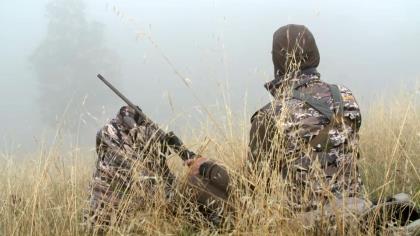
Browning's Exclusive OVIX Camo Gives You Complete Concealment
Editor in Chief, Haynes Shelton breaks down Browning's OVIX camouflage. After years of testing, the North American Whitetail team depends on OVIX in the field. With its highly effective and versatile detail throughout, the intentionally placed browns, grays, and greens are guaranteed to break up any outline no matter the distance. Using this pattern from the southeast to the far north, it's shown time and time again this revolutionary camouflage's effectiveness.
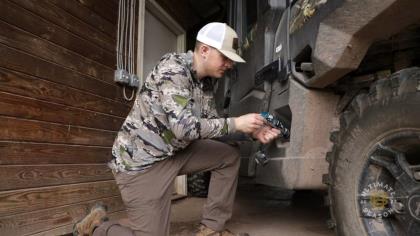
Start to Finish Success for Ultimate Season Bucks
As a whitetail hunter and landowner dedicated to pursuing great bucks each season, North American Whitetail's Blake Garlock depends on a lot of motorized gear from September to late January. Whether it's a side-by-side UTV, a chain saw, a tractor, or a powered-up limb saw, Garlock relies on Star brite's Quick Fix Engine Rescue to keep his engines running smoothly for months on end. From planting food plots to trimming up shooting lanes to driving to and from a stand, Garlock depends on Star brite's Quick Fix blend of polyetheramine (P.E.A.) and proprietary Star Tron ENZYME technology to keep fuel systems clean, moisture at bay, deposits removed, and top-end fuel efficiency leading to fast engine start-up and all-season success.
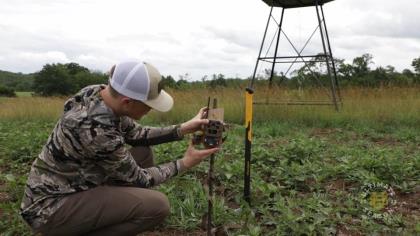
Year-Round Deer Scouting with Moultrie Mobile Edge Cellular Trail Cams
North American Whitetail's Blake Garlock shares his strategies for trail-cam use during four distinct times of the year, from pre-season to post-season, using Moultrie Mobile cams.

GET THE MAGAZINE Subscribe & Save
SUBSCRIBE NOW
Give a Gift | Subscriber Services
PREVIEW THIS MONTH'S ISSUE
Buy Digital Single Issues
Don't miss an issue. Buy single digital issue for your phone or tablet.
Other magazines.

Guns & Ammo

North American Whitetail

See All Other Magazines
Special Interest Magazines

2023 Backcountry Hunter Fall

2023 Crossbow Revolution #2

2023 Tree Saddle Hunter

2023 Hunting Gear Guide

2023 Public Land Hunter
See All Special Interest Magazines
More You May Be Interested In

Get the top North American Whitetail stories delivered right to your inbox.

Get Digital Access.
All North American Whitetail subscribers now have digital access to their magazine content. This means you have the option to read your magazine on most popular phones and tablets.
To get started, click the link below to visit mymagnow.com and learn how to access your digital magazine.
Get Digital Access
Not a Subscriber?
Enjoying What You're Reading?
Get a Full Year of Guns & Ammo & Digital Access.
Offer only for new subscribers.
Subscribe Now

Our Social Networks

What is the size of the home range for white-tailed deer?
By growingdeer, 04/26/2011.
Filed under: Ask Grant , Deer Biology
I love your show!
Some deer do stay within a few miles of where they were born and others move many miles. There are several factors that determine if and how far a deer disperses from its place of birth. Male fawns are usually forced to disperse from their mother’s home range. If the doe dies before it is time for the male fawn to disperse, he tends to remain in the same area where he was born. This is one advantage of harvesting does!
If the doe is alive and she forces the young male to disperse, the distance he will travel is influenced by the quality of the habitat, the local deer herd density, predator population, and several other factors. As biologists learn more about deer by using GPS collars and other neat tools, we are discovering that deer are like humans in that each one is a unique individual. The averages often quoted for home range size, distance of dispersal, etc., rarely closely represent a large percentage of the population due to the individual nature of deer.
Growing Deer together,


- May 16, 2023
Strategies for Success in Deer Travel Corridors
What are deer travel corridors.

A travel corridor is the pathway that deer use to navigate their habitat. These corridors play a crucial role in their movement patterns, connecting key areas such as food and bedding areas. Understanding the concept and importance of a travel corridor is vital for effective habitat management and hunting success.
Deer are creatures of habit and often like to travel along the path of least resistance. Having the ability to manipulate the landscape to influence deer movement through a travel corridor is one of the fastest ways to improve your whitetail property.
These corridors provide them with a sense of security while minimizing their exposure to potential dangers. By utilizing travel corridors, deer can conserve energy and reduce their risk of predation.
Designing Effective Deer Travel Corridors
Crafting an effective travel corridor combines the natural features of the land and integrating them with strategic habitat improvements. Consider the following when designing a travel corridor:
Understanding how whitetails work their way through the landscape naturally is a priority to creating an effective corridor. Identifying key hill features such as saddles, benches, or drainage tops and natural waterways like streams, creeks, rivers or swamps can work as a guide for design.

Thick Cover
Whitetails, especially big bucks naturally want to spend a majority of the daylight hours in thick cover. It is great for bedding, and provides them with safe cover.
As mentioned earlier, deer like to walk the path of least resistance. While this thick vegetation can be great for bedding, oftentimes deer travel along the edge as it can create natural corridors when located next to open timber.
Existing Features
Tapping in to your creativity and utilizing remnants of the past can significantly influence deer movement. Some great examples of this can come on an old farm.
Working with a fence line along the edge of abandoned fields or a fence around an old cattle pasture can create narrow travel corridors. Sometimes these fences are paired with an open gate which works as a great pinch point and can be a perfect place to hang a trail camera.
Corridor Width
The ideal width when creating a travel corridor will vary based on things such as location and vegetation. Using a brush hog to mow a narrow strip of cut grass along the edge of a field can be just as effective as dropping trees parallel to a bench within a stand of timber.
The important thing here is to take the wildlife and surrounding environment into consideration and ensure those big bucks have adequate cover and will feel safe while walking the trails.

There are multiple ways to use food plots to your advantage when creating a travel corridor.
Strategically pairing food plots and bedding areas throughout your property and creating systematic travel routes is a great way connect the pieces of a puzzle and keep a mature buck moving within your property rather than through it.
Utilizing trail food plots within the corridor itself is another great way to motivate deer to use it as one of their primary travel routes.
Bedding Areas
Establishing bedding areas adjacent to the trails can create great rut funnels for big bucks to travel during early November.

Water Holes & Mock Scrapes
These subtle habitat improvements can be great additions along the trail. Installing these in the right location near food plots or a bedding area can provide hunters with a great opportunity to get their target buck in bow range during the pre-rut.
How to Hunt Travel Corridors
Understanding deer behavior within travel corridors and employing effective hunting strategies can significantly increase your chances at tagging your target buck. Consider the following tips when hunting travel corridors:
Use trail cameras to monitor deer activity along the travel corridor and see if you can develop any patterns or narrow down the home range of a certain buck. Great camera locations are near natural funnels such as saddles, old fence lines, or a natural cross of a small creek.
Keeping bedding areas, food plots, and other natural food sources in mind, determine where the deer are most likely to be and where they want to go to determine the optimal set-up to hunt.
Look for pinch points, which are narrow sections of the corridor that funnels down deer movement. This is where you can set up tree stands or ground blinds to increase the likelihood of deer sightings.
Consider wind direction and thermal currents to position yourself downwind of the expected deer travel route.
By understanding deer behavior, identifying key locations within travel corridors, and implementing effective hunting strategies, you can significantly improve your probability of success whether hunting in the trees or on the ground.

Whether your whitetail property is located in the low wetlands along the coast, among the massive plantation of pines in the south, or anywhere in between, a strategically placed travel corridor is one of the most effective ways to funnel deer movement.
Developing and managing these funnels requires dedication and effort, but it is also a highly rewarding project that can help you change your property for good while securing long-term success for future generations.
Recent Posts
7 Keys to Super-Charge Your Mock Scrapes
Different Types of Hunting Blinds and Stands for Whitetail
Finding the Right Real Estate Agent for Hunting Land
- Bear Hunting
- Deer Hunting
- Hog Hunting
- Predator Hunting
- Turkey Hunting
- Waterfowl Hunting

Gearing Up for Spring Gobblers: Roosting Techniques for Silent Gobblers

Whitetail Playbook: Spring/Summer Nutritional Calendar

Understanding The King of Spring

Whitetail PlayBook:Planting Spring Food Plots? Start With the Weeds

Venison Garbage Plates

Bear Recipe – Pulled BBQ Bear Sandwiches

Buffalo Style: Deep Fried Wild Turkey Cutlets

Wild Turkey Jalepeno Poppers
![The Best Deer Camp Chili [VIDEO] Deer Chili Ingredients, Tomatoes, Chili Spices](https://www.thehuntingpage.com/wp-content/uploads/2015/10/Deer-Chili-Deer-Camp-Recipe-218x150.jpg)
The Best Deer Camp Chili [VIDEO]

Gearing up for Spring Gobblers: Trail Cameras

Introducing EIKONIC Knife Company: Bringing Unreal Quality and Value to the…

Great Gear for Late-Season Turkey Hunting

This Archer Can Shoot Three Arrows in 0.6 Seconds

Whitetail Playbook:Trail Camera Game Changer “Silica Gel Packs”

Whitetail Playbook: Spring Whitetail Scouting

Whitetail Playbook:Apple Tree Maintenance for Deer and Better Deer Hunting

Whitetail PlayBook: Turn Your Deer Hunting Around with Food Plots

Whitetail PlayBook: Building Successful Deer Plots
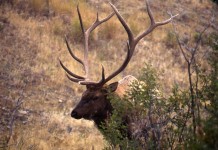
How to Call Elk Early in the Season [VIDEO]

CRAZY Hunt With Huge Turkey At 10 Steps
How to identify deer travel routes.
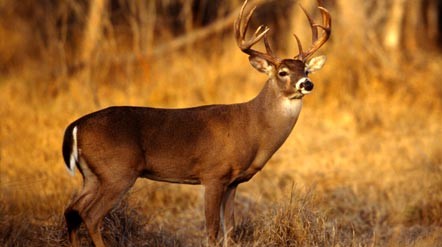
Slow down, observe, and listen
Hunters know identifying a quality stand site takes more planning in advance than simply heading to a hunting lease, finding a tree that looks like it’s in a good spot, and hanging a stand. You must account for wind direction and the travel patterns of wildlife in order to locate a spot that will give you a good chance of spotting and harvesting deer. A good place to start is understanding travel routes.
Understanding Deer Behavior in Early Spring:
Early spring, the whitetail world is waking up. Winter’s grip is fading, and the deer are shifting from surviving to thriving. Food sources are changing with fresh green shoots popping up, and deer are adjusting accordingly. They’re sticking close to their bedding areas and following familiar routes that offer the easiest path to food and water.
Identifying these routes means reading the signs left behind by these crafty critters. But it’s not just about recognizing a track or a rub – it’s about understanding what it all means in the bigger picture.
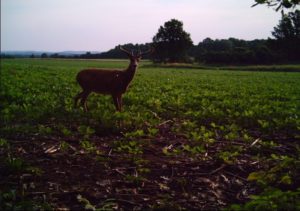
Reading the Land
Deer aren’t random wanderers. They use the lay of the land, following ridgelines, creek bottoms, and fence lines. Look for these features, and then watch for signs of deer activity – tracks, droppings, rubs – they’re all telling a story.
Food and Shelter
In early spring, a deer’s mind is on food. They’re looking for green shoots, agricultural fields, food plots, and clear-cuts. Spot these areas and you’ve found the dinner table. Next, look for the bedrooms – deer like thick, brushy cover, or areas with a mix of young and mature trees. Position yourself between food and shelter, and you’re in the game.
Every Region Has Its Story
Deer habits can change depending on whether you’re hunting in the Northeast, Midwest, or the Southeast. It all depends on how harsh the winter has been. State fish and wildlife agencies like New York Department of Environmental Conservation or the Texas Parks and Wildlife Department can offer some great insights into regional deer behavior.

The Trail Camera Advantage
Trail cameras, like those from our friends at Muddy Outdoors , can be your eyes in the woods 24/7. They’ll capture deer movement and help you see patterns you’d miss otherwise. Set them up along suspected travel routes, near food sources, and around bedding areas. Remember, you’re trying to capture a deer’s world, so think like a deer when you set up your camera.
Scouting and Shed Hunting
Spring is a perfect time to scout. As the snow melts, deer signs from the previous fall start appearing. Look for last year’s rubs, scrapes, tracks, and trails. Finding sheds can also give you a good idea about buck travel routes.
Piecing It Together
Finding deer travel routes in early spring is like solving a puzzle. You’ve got to put together landscape features, food sources, bedding areas, regional differences, and game camera intel. It’s a test of patience, knowledge, and love for the hunt.
7. Pay Attention to Changing Conditions
We hunters know that the woods are always changing, always adapting. Over the years, many of us have noticed subtle shifts in the behavior of our whitetail friends. These aren’t just random variations – they reflect the changing conditions in our forests and fields.
In recent years, we’ve noticed that early springs are warmer than they used to be. This is affecting the green-up dates of plants and crops, which in turn impacts when and where deer move in search of food. The green-up is starting earlier, meaning the deer are shifting their patterns sooner.
As a hunter, it’s essential to stay alert to these changes. The traditional dates and signs that used to signal the start of spring and the shifting of deer travel routes might not be as reliable as they once were. If you notice that the underbrush is getting greener earlier or that crops are sprouting sooner, it might be time to start scouting those deer travel routes earlier in the season.
This shifting timeline also means that food sources that were traditionally available later in the spring might now be accessible to deer in the early spring. This can result in deer changing their routes to take advantage of these early-blooming food sources. So, if you’ve got a food plot or know of a crop field that’s showing green early, keep a close eye on it. It might just become a hot spot for deer activity.
Conclusion:
Finding deer travel routes in early spring is a journey of discovery. It’s about understanding the whitetail’s world and learning to see the woods through their eyes. Here at thehuntingpage.wpengine.com, we’re committed to helping you understand, respect, and ultimately be successful in this world. As you step into the woods this spring, remember to slow down, observe, and listen. The deer are the true masters of this game, and they’ve got a lot to teach us. So, lace up those boots, grab your gear, and let’s get out there. The woods are calling, and the whitetails are waiting. Now get after it!
Photo: Wyoming Game and Fish
RELATED ARTICLES MORE FROM AUTHOR

POPULAR POSTS

This Was the Last Thing Taxidermists Were Expecting to Find Inside...

Idiots Disturb Hunter: How Would You Have Handled It? [VIDEO]

Albino Buck Shocked to Shed His Antlers [VIDEO]
Popular category.
- Hunting 2864
- Deer Hunting 1455
- Outdoors 846
- Conservation 487
- Turkey Hunting 368
- Fishing 251
- The Feature 203
- Wired To Hunt
You Won’t Believe How Far this Buck Traveled
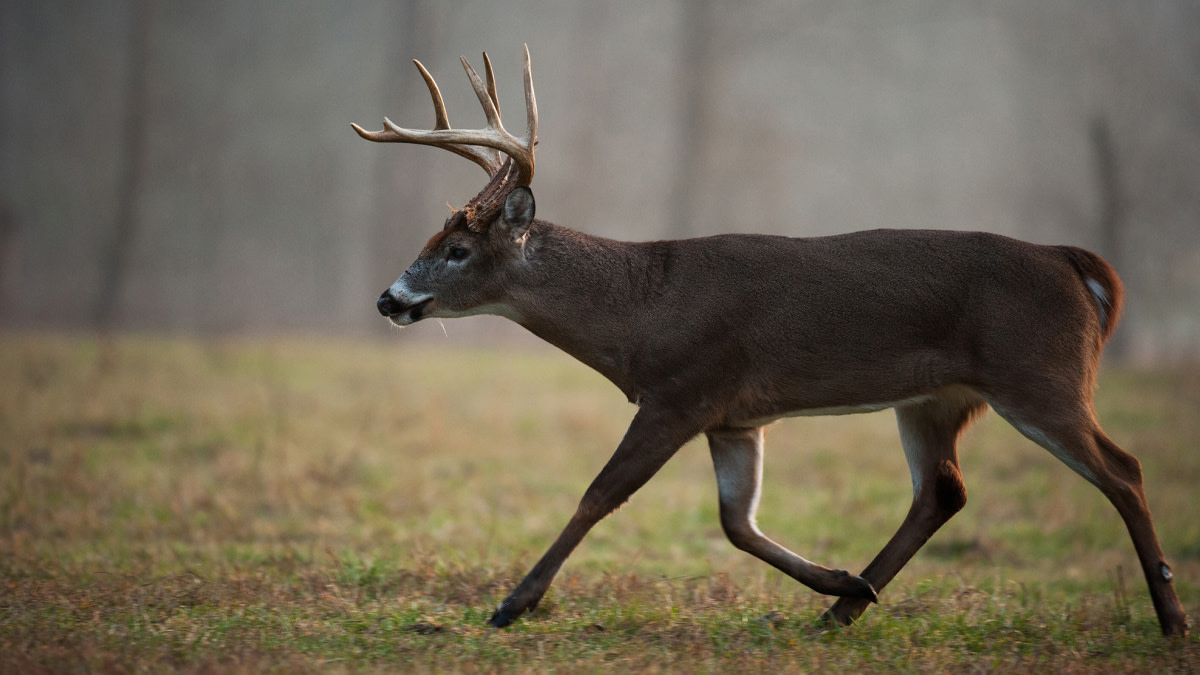
It’s that time of year again. From Texas to Maine, whitetail hunters are feverishly pulling trail cam photos to take a first look at the bucks in their area. For those disappointed with their results, a new paper published in “Ecology and Evolution” might offer some hope.
Researchers in Missouri tracked what appears to be the farthest journey ever recorded by a whitetail buck. Over 22 days in November of 2017, this whitetail—who I’ve decided to call “the Odysseus deer”—took an astounding 186-mile trek through northern Missouri, averaging about 8.5 miles per day.
He wasn’t just moving in circles, either. His straight-line journey measured 133 miles across 16 counties, 108 miles longer than any male whitetail recorded in scientific literature. He also crossed a major river seven times, an interstate highway, a railroad, and eight state highways.
The 3.5-year-old buck made this journey smack in the middle of Missouri’s whitetail season. While no Missouri hunter capitalized on the deer’s movement, if there are more like him out there, hunters can always have hope that a big buck might wander in with the next sunrise.
A Historic Journey The researchers who published the paper are working on a more extensive study tracking the survival, population recruitment, habitat use, and resource selection of whitetails in Missouri. They put GPS collars on 343 whitetails, including 58 adult males and 123 male fawns. The Odysseus deer, known in the paper as N17003, was collared when he was 2.5 years old and appeared totally healthy.
One of the study’s authors, Jon McRoberts, told Tony Peterson on a recent episode of Wired To Hunt that he learned about the deer when someone sent him a picture of a collared buck far outside their study area. He at first thought it was a joke, but when he went back to the tracking data, he found Odysseus right away.
“I said, ‘Holy smokes!’ I saw this line going across northern Missouri. It was a bit of a shock when I drew up all the locations for the first time,” he told Peterson.
This whitetail is unique for a few reasons. While females have been known to travel great distances, they’ve never been recorded traveling such a long straight-line distance. One female, for example, moved 287 miles but only dispersed 25 miles.
Odysseus’ 133-mile straight-line journey is even more uncommon for an adult male. However, juvenile whitetail bucks will often travel to avoid inbreeding, escape competition or hunting pressure, and find available mating partners. The previous record for male whitetail movement, 132 miles, was made by a yearling in South Dakota.
But adults rarely travel any great distance. While even the average juvenile only disperses in the tens of miles, adults in an established range are even bigger homebodies. Prior to this paper, the longest recorded journey of an adult whitetail was only 25 miles, according to the paper’s authors.
“The sheer length of the movement is incredible. Add to that length the fact that this is a mature buck, and you have a very unique event,” lead author Remington Moll told MeatEater. “I am also impressed that this individual moved so far during rifle season in a state with more than half a million hunters-and survived!”
Why Would a Buck Travel So Far? Why would a healthy, adult male whitetail make such a long journey? A combination of factors urged Odysseus onward, but researchers can’t say which was most important.
“As with many things in nature, the movement is likely a combination of factors—a bit of mate competition, perhaps some increased movement due to hunting pressure, a dash of habitat fragmentation due to landscape development, and the fact that individual animals behave differently. Put those factors together, and they begin to explain the movement,” Moll said.
McRoberts is somewhat less convinced that the typical reasons a deer might disperse apply in this case. He pointed out that N17003 had access to suitable habitat all along his route, likely encountered tons of females, and wasn’t facing social pressure due to his age.
“I think this was an individual deer that was just marching to his own beat,” he said. “A deer hunter would like a better answer. I’d like a better answer as a biologist. But you think of the conventional wisdom that would drive a deer to disperse. That wasn’t the case here.”
Whatever motivated the Odysseus deer, he was getting there quick. The deer traveled mostly at night when his movements were faster and more directional than during the day when he camped out in forested locations.
We asked Moll whether this directional movement indicated that the deer had a particular location in mind, but the biologist pointed out that dispersals often follow this pattern.
“Dispersal movements are often directional. Biologically, a straight line is often an efficient way to ‘get away’ from undesirable processes like inbreeding,” he said. “The straight, fast nature of the movement is not surprising. Rather, the surprising aspects are the incredible length and that this movement was performed by a mature buck rather than a yearling.”
Why Is This Deer Important? Unusual animals are always interesting, but this deer is important for a few more practical reasons.
First, N17003 could influence how state wildlife agencies manage the spread of deer-borne diseases like chronic wasting disease (CWD). Current policies keep normal deer behavior in mind, but if Odysseus deer are more common than we think, agencies might need to rethink CWD-affiliated hunter regulations.
McRoberts cautioned that wildlife experts can’t make policy based on outliers, and he didn’t call for agencies to change CWD mitigation strategies based on a single deer. But Moll told us the paper does highlight the importance of inter-organization cooperation and the need for a big-picture approach .
“The Missouri Department of Conservation funded this work in partnership with the University of Missouri and the University of Montana. This study highlights the benefits of such partnerships and the need to continue to monitor populations as humans change the landscape through development and activity,” he said. “Certainly, the sheer scale of the movement emphasizes the importance of broad, landscape-scale strategies for disease monitoring and mitigation.”
The paper also proves that what we often consider impassable barriers aren’t always so impassable.
“Depending on the landscape context, cities, roads, and rivers can all act as movement barriers for white-tailed deer. In the case of N17003, the study area's major river presented little impediment to movement, while roads and cities appeared to influence, but not obstruct, the overall dispersal trajectory,” the authors wrote.
The question, of course, is whether N17003 is a one-in-a-million outlier or a one-in-a-thousand outlier. Biologists are reasonably sure the Odysseus deer is rare, but tracking studies typically only document the movements of a tiny subset of populations.
“In a state such as Missouri with over 1 million deer, long-distance dispersals might be rarely documented in practice but fairly commonplace in reality across larger populations,” the authors write.
Either way, McRoberts says we’ll be able to answer that question in the coming years. GPS technology is becoming more accessible, which will enable biologists to track a deer’s movement no matter where it goes on the map.
“Did we get lucky and happen to collar a very unique individual ? Or do these movements happen more frequently than we realize?” Moll asked. “One study cannot provide those answers, but it will hopefully inspire future discovery.”
For now, hunters can hope that they’ll run across an Odysseus deer this fall—or, more accurately, that an Odysseus deer will run across them. Hopefully, it won’t be quite as elusive as N17003. The rambling deer survived Missouri’s 2017 whitetail season and lived until June of 2018 when researchers believed he died of a hemorrhagic disease.
Feature image via Matt Hansen.

Sign In or Create a Free Account

How Far is Too Far to Shoot a Deer with a Bow?

I recently made the mistake of searching YouTube for long-distance bow shots. While some practice session of insanely far distances showed up, a long list of hunting videos with farther-than-average shots populated the results as well. Now, far is subjective. A 60-yard poke to one archer might be the equivalent of a 30-yard shot to another. Even with vastly different skillsets, attention to equipment, and discipline at the range, there is still a...

How to Double-Team Track a Buck

One of the best things about tracking a buck is that it’s done solo. You’re out in the deep woods, just you and the buck, in a mano-a-mano duel of predator and prey. To be successful, you must rely on your skills as a hunter and as a woodsman, reading the signs and covering ground on your way to catch up with the deer. However, there are some downsides to hunting on your own. You could take a bad spill or get hurt in some way and have no one...

How to Track a Buck in the Big Woods
His name was Ernie. The sun has just gone down on the last day of the Vermont deer season when the flannel-clad old man with a white beard backed his rusty Chevy into the parking lot with the antlers of the biggest 10-pointer I’d ever seen sticking up from the tailgate. I was 17 years old, sitting in my car outside the general store and big game check-in station, eating beef jerky and begrudging my rotten luck. I hadn’t gotten a buck and had only...


If you are ever in Moscow, you should look at The Golden Ring , a ring of towns and cities north east of Moscow which played an important part in the formation of Russia and the Russian Orthodox Church. The towns themselves are almost like museums and none more so than the jewel of the Golden Ring, Suzdal . You have to visit this town if you are in Moscow and I will tell you exactly how to get to Suzdal from Moscow.
You can do this in a return day trip to Moscow, just, but I recommend staying the night in Suzdal. That will give you the afternoon on the 1st day and the morning and early afternoon on the 2nd day to explore which should be enough time. You can get a bus from Moscow to Suzdal. However, there is only one bus a day and it is not very comfortable. A better option is to get a train to the nearby city of Vladimir and from there get a bus to Suzdal. There are multiple trains every day from Moscow and buses are almost every 30 minutes so you will not have to wait long in Vladimir.
Getting the train to Vladimir
Go to the state run website for Russian railways . In the departure station, click (or type) ‘MOSKVA’, in the arrival station type ‘VLADIMIR”, select your departure date (and return if you will go back to Moscow the next day) and click on the buy ticket button. You will have multiple trains to choose from. The fastest trains do the journey in about 1 hour 45 minutes. Be sure to check which of the Moscow train stations your train will depart from. More than likely this will be Mockva Kurskaia. Whichever station it is, you can get there very easily by using the metro .

How to get to Suzdal from Moscow? By train of course
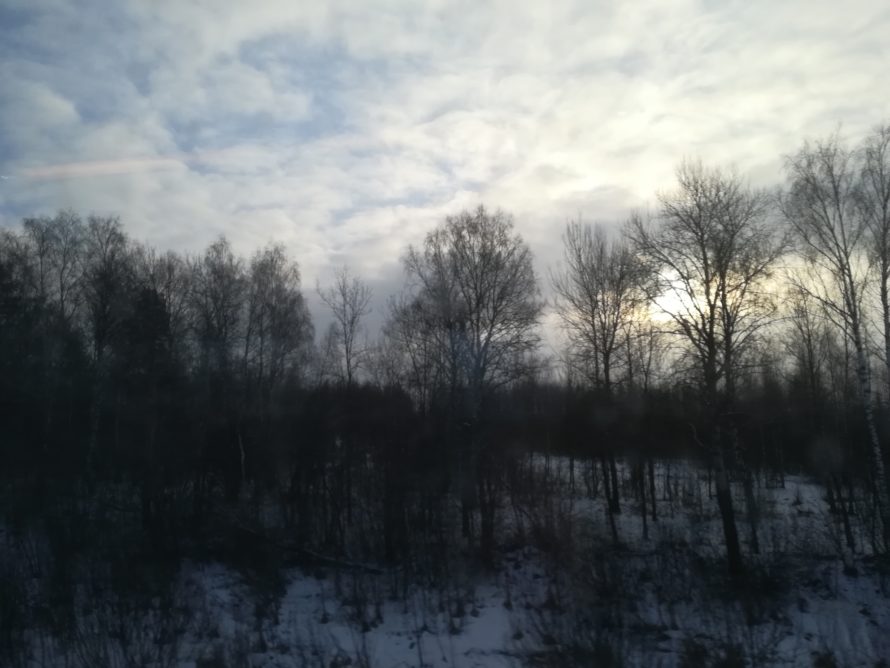
Looking out train window
Getting Bus from Vladimir to Suzdal
When you arrive at the train station, follow everyone else that is leaving the train station. When you get outside, if you look across the street, you will see the bus station. The facilities in the bus and train station are pretty basic. the train station is a little better so if you want a coffee or something to eat, I would get it there.
In the bus station go to the ticket office and get a single ticket to Suzdal. Something like “odin billet Suzdal” should be enough to be understood. The ticket costs 98.50 rubles so its easier to have a 100 ruble note to get change from.
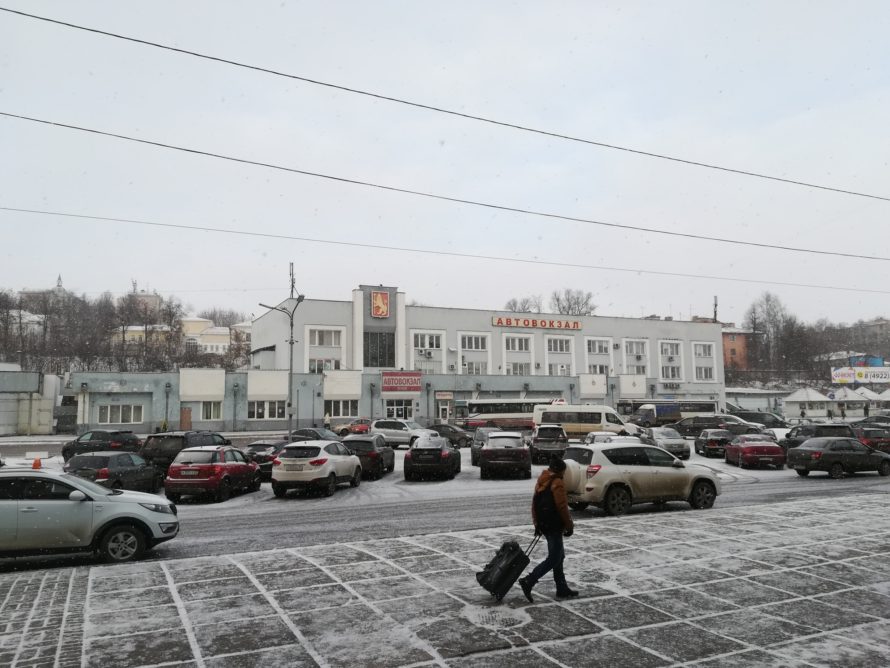
At the exit of the train station, the bus station is directly across the road

Bus timetables

And more timetables
My ticket to Suzdal is bus number 159, platform 10 at 12:00 and seat number 6.

Bus ticket to Sudal
When you have your ticket, go outside to the platform listed on the ticket and wait for the bus. Simple really!

Not the actual bus in the end. The bus was more of a minivan.
Staying the night in Suzdal
There are a lot of accommodation options available in Suzdal. The place i stayed is Suzdal Hotel . It is actually a house and they have a few rooms available. The breakfast that is included is very very good. Trust me on this. They will even collect you from the bus station in Suzdal and bring you back the next day.
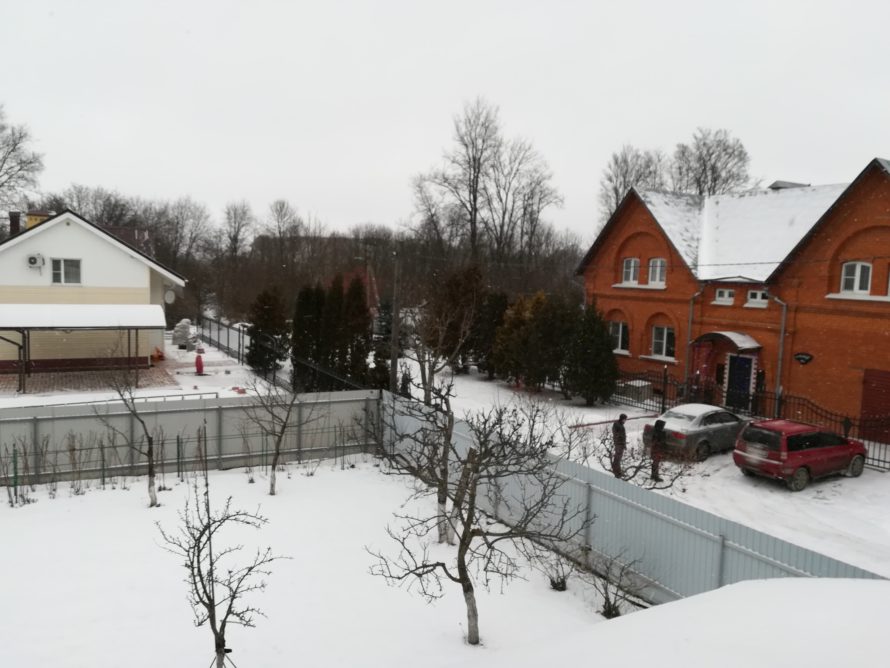
View out my bedroom window
Returning to Vladimir (and Moscow)
To return to Vladimir, just repeat these steps in the opposite direction – return to the bus station in Suzdal, buy a ticket to Vladimir and continue your onward journey in Russia. Simples! 😉

Train to Nizhny Novgorod
You Might Also Like

The Most Beautiful Stations on the Moscow Metro
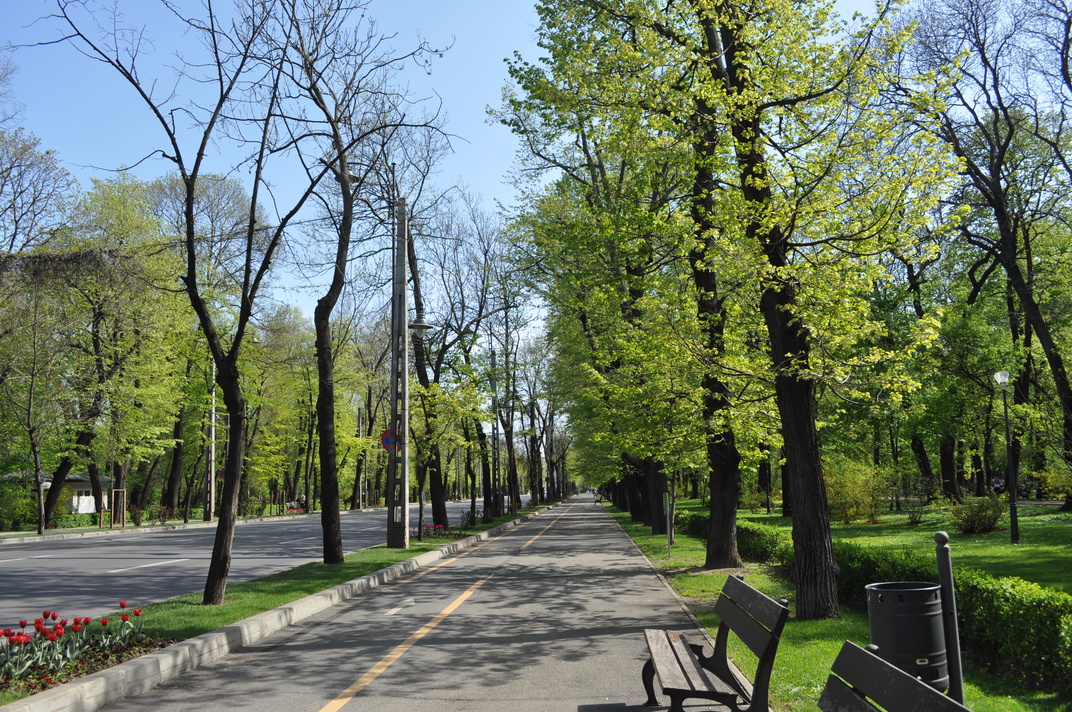
One Afternoon in Bucharest: Blast from the Past

Visiting The Museum of Cosmonautics in Moscow
22 comments.
Melissa Butler
I went to Suzdal over 13years ago for Christmas, I was on an on the go tour and they organised the train for us which was a very interesting journey. I would love to go back and explore longer. I am definitely impressed that you have done it on your own and it sounds like you had a bit of an adventure :).

Hi Melissa, it certainly was an adventure that’s for sure! Though sometimes, there is something to be said for letting other people take care of things for you and getting to relax and not be too stressed.
Sandy N Vyjay
Moscow is a place with an intriguing and enigmatic history. Suzdal seems to be a charming place with a rich heritage. As you have mentioned it seems to be a living museum of sorts. Nice step by step instruction on getting to Suzdal from Moscow. This is indeed an invaluable resource for first-time travelers to Russia.
Thank you very much for your kind words. I hope some people find it useful!
Thanks for recommending the Suzdal Hotel, since I prefer to stay in small cozy places with good breakfast. And the service of taking the guests from and to the bus station in Suzdal is a great plus!
Yeah I agree. I would rather stay in a family type place than a bigger place too!
I have never heard of this town and it sounds like a great place to visit if you are already in Moscow. Your instructions are very helpful and I like how you put a photo of the ticket.
You’re welcome Candy. If you don’t speak the language, Russia can be difficult to get around.
Michael Hodgson
Fantastic detail and extremely useful post for anyone wanting to explore outside of Moscow. Suzdal does sound fascinating.
Thanks Michael!
This seems like quite an experience! I am surprised that I haven’t heard of Suzdal before but as soon as I go to Moscow, I will have to do a day trip to there. Is a day trip enough to explore Suzdal?
Hey Lydia, you certainly can! If you go early enough in the day to Vladimir, you can probably get 6-7 hours in Suzdal.
This is a great post with quite a few good details. Pics looks so amazing. Thanks for sharing and keep up the good work.
Thanks. Glad you enjoyed!
Wow, you are adventurous! I spent years upon years in Russia and never made it to Suzdal. Never realized Vladimir was less than 2 hrs away from Moscow.
Thanks Jenia. Russia is a huge place. You could live there your entire life and not see it all!
Thanks for the instructions. If I ever want to visit Suzdal I now know how to get there from Moscow via Vladimir.
You’re welcome!
Lauren Pears
Suzdal sounds really lovely! I need to travel to more places where there will be snow rather than just constantly chasing the sun 😉
I know what you mean! After 4 months of winter in Russia though, I was craving the sun so much!
I had never heard of Suzdal until now. Thank you for introducing me to a new place. It looks so calm and quiet under the snow. What are some things to do in Suzdal?
I think it is the sort of place you go to get away from the craziness of big cities and have some slower, quiet time. If my memory is correct, they also have a cucumber festival once a year every July. Apparently the cucumbers of the area are very good!
Leave a Reply Cancel Reply
Save my name, email, and website in this browser for the next time I comment.
Notify me via e-mail if anyone answers my comment.

IMAGES
VIDEO
COMMENTS
Fortunately, some deer researchers in Texas may have figured out what is going on. Every fall whitetail deer go through a 1- to 3-month-long breeding season that we call the rut, and in that time a mature doe will become sexually receptive for only a short period of 1 to 2 days. During the rut, bucks are known to change their movement behavior ...
Deer can cover an average distance of 1 to 200 miles, depending on the amount of forest cover in the area. The average travel distance for young bucks is lesser and ranges from around 2 - 23 miles or more. This is also dependent on how well the area is covered. On the other hand, a mature buck can travel as long as 200 miles.
In agricultural areas like the Midwest, where the kitchen is next to the bedroom, deer may have relatively small home ranges. Shifting Seasons Another thing that can influence home range movement is climate. Deer hunters living east of the Mississippi and south of the Mason-Dixon Line may not fully appreciate just how dramatic the changes can be.
Deer Herd Day & Night Movement (2024) Determining how far do deer travel is one of the major things for every hunter. Tracking their pattern is essential to make the most of your hunting. It helps you to figure out where you can find deer in great numbers. On a broader range, the average distance that deer can travel in a day is 1.9 to 23.6 miles.
Hunt High The first thing you need to know is that once you get down into tricky topography like valleys, saddles, and draws, the wind is going to begin doing funky things. I once heard wind described as water flowing in a creek. When the water runs over pebbles or hits a large boulder, it forms rapids, goes around it, swirls or eddies.
B. Take a stand along side the movement, between bedding opportunities and the evening food source for all day buck cruising activities or afternoon food source movement patterns. C. Hunt the food source end of the movement during the afternoon, in a stand that allows you to get in and out of the food source without spooking the deer herd.
The home ranges of whitetail bucks in excellent habitat with plenty of food available may be quite small. GPS studies in prime areas of Louisiana, Pennsylvania, and Maryland showed home ranges ...
The whitetail deer is a wild counterpart to domestic sheep and goats, because they are all ungulates, ruminants, and they are all short-day breeders. After the summer solstice occurs on June 21, each day's length begins to shorten. In my area of Illinois, the summer solstice results in roughly 15 hours of daylight and only 9 hours of darkness.
Well a Missouri buck proved that it's time to think bigger, people. The Show-Me State buck, a 2-½ year old whitetail known to state researchers as N17003, lit out from his home range and walked ...
Understanding deer activity starts by looking into home range, defined as the area used by a deer during the normal daily activities of eating, mating and raising young. Whitetail home ranges vary drastically based on many factors and can range from 250 to 2,500 acres. Typically, areas with a consistent mix of food, cover and water lead to ...
Wanderlust took on a whole new meaning in the whitetail deer woods after a radio telemetry study found that a Missouri buck traveled 8.5 miles per day, logging nearly 200 miles in just 22 days, during the 2017 rut. The University of New Hampshire published the study in the journal Ecology and Evolution. Researchers analyzed data from GPS radio ...
Karns found that only 63 percent of all bucks monitored made an excursion, and 59 percent of them did so around breeding season. On average, bucks that took excursions during breeding time were only gone for 10.5 hours, and only 59 percent of them traveled during daylight hours.
The 2 1/2-year-olds travel widely, having ranges much larger than even 3 1/2-year-olds. Many bucks 5 1/2 or older have tiny core areas in which they've learned they can feel secure. These deer are big enough to take over the best of the best bits of security cover from other bucks if they so desire. Excursions
[question] Do deer stay within a 2 mile radius from where they are born? I love your show! Zack [/question] Zack, Some deer do stay within a few miles of where they were born and others move many miles. There are several factors that determine if and how far a deer disperses from its place of birth. Male fawns are usually forced to disperse from their mother's home range. If the doe dies ...
Consider the following tips when hunting travel corridors: Use trail cameras to monitor deer activity along the travel corridor and see if you can develop any patterns or narrow down the home range of a certain buck. Great camera locations are near natural funnels such as saddles, old fence lines, or a natural cross of a small creek. Keeping ...
Average dispersal distances for young bucks might range from less than 2 miles to more than 23 miles, depending upon the amount of forest cover available. Typically, scant forest cover (less than 35 percent or so) contributes to earlier (spring) dispersal and to greater dispersal distances (sometimes in excess of 100 miles).
Finding deer travel routes in early spring is like solving a puzzle. You've got to put together landscape features, food sources, bedding areas, regional differences, and game camera intel. It's a test of patience, knowledge, and love for the hunt. 7. Pay Attention to Changing Conditions.
The best time to hunt whitetails is whenever you can get into the woods. With that said, there are a couple of occasions when it's an extra-good idea to be in your stand. The first is on opening day of the firearm season. In most states, opening day accounts for 50% or more of the entire annual whitetail harvest.
May 8—AUSTIN — Texas Parks and Wildlife Department (TPWD) is seeking public comment until May 22 on proposed deer carcass disposal regulations and movement restrictions.
Researchers in Missouri tracked what appears to be the farthest journey ever recorded by a whitetail buck. Over 22 days in November of 2017, this whitetail—who I've decided to call "the Odysseus deer"—took an astounding 186-mile trek through northern Missouri, averaging about 8.5 miles per day. He wasn't just moving in circles, either.
Welcome to the 628DirtRooster website where you can find video links to Randy McCaffrey's (AKA DirtRooster) YouTube videos, community support and other resources for the Hobby Beekeepers and the official 628DirtRooster online store where you can find 628DirtRooster hats and shirts, local Mississippi honey and whole lot more!
You cannot resist our Two Hearts of Russia (7 Days &6 Nights), Golden Moscow (4 Days &3 Nights), Sochi (3 Days & 2 Nights), Golden Ring (1 Day & 2 Days), and many more. As a leading travel agency specializing in the tour to Russia and Former Soviet Republics, we are connecting the travellers from every part of the world for more than 10 years.
Go to the state run website for Russian railways. In the departure station, click (or type) 'MOSKVA', in the arrival station type 'VLADIMIR", select your departure date (and return if you will go back to Moscow the next day) and click on the buy ticket button. You will have multiple trains to choose from. The fastest trains do the ...
Richard and Greg Davies attempt to extract the essence of Moscow in two days, as they clash with army tanks, head into space and visit one of the strangest c...